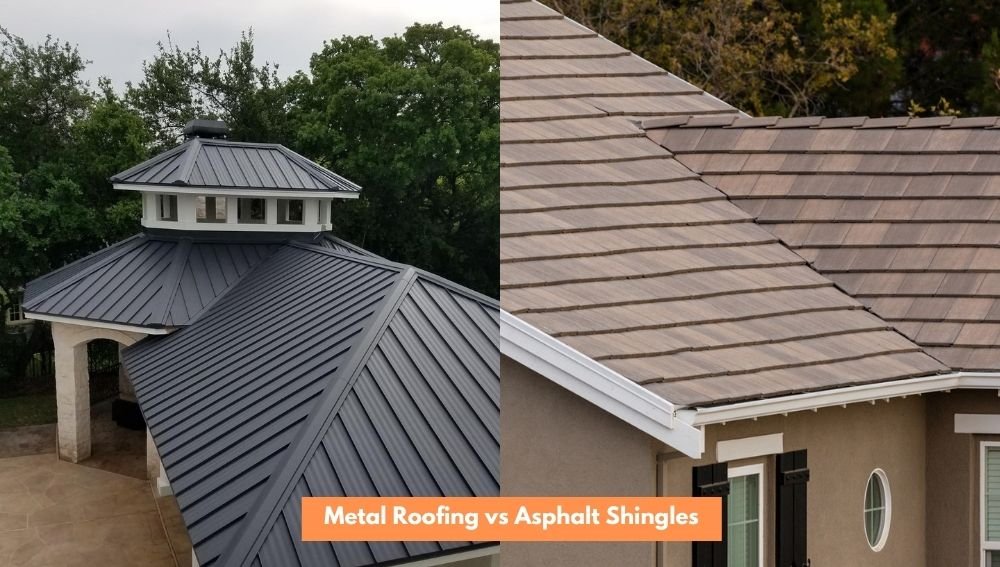When it comes to roofing options, two popular choices that often come up are metal roofing and asphalt shingles. Both materials have their unique characteristics and advantages. Metal roofing offers:
- Durability
- Longevity
- A sleek modern aesthetic
while asphalt shingles provide:
- Affordability
- Easy installation
- A traditional look
In this article, we will explore the major differences between these two roofing options, as well as their pros and cons.
Understanding the distinctions between:
allows you to make an informed decision. Choose the roofing material that best suits your needs, preferences, and budget.
We will explore the major differences between these two roofing options. We will also look at their pros and cons. Understand the distinctions between metal roofing and asphalt shingles. Choose the roofing material that best suits your needs, preferences, and budget.
In general, metal roofs cost more during the initial construction. They tend to must less maintenance. Shingle roof construction remains the most common in the industry. It’s likely because it remains the most affordable.
Free, No-commitment Estimates (CTA)
The beginning half of 2021 saw an unprecedented labor shortage as a side effect of the COVID-19 pandemic. In conjunction with this, demand for materials and construction jobs skyrocketed. As a result, material prices reached the highest in the market, and lead times were longer than usual for both labor and materials.
Critical Differences Between Metal Roofing Vs. Asphalt Shingles
What Are Asphalt Shingles?
Shingles come in:
- Sheets
- Stacks
- Rolls
And are mostly:
- Uniform in design and composition
- A ceramic granular upper surface
- Smooth asphalt layering over a fiberglass base
Shingles are often:
- Nailed onto wooden-framed roofing structures
- Layered
- Staggered upward
From The Lowest Point On a Sloped Rooftop
Manufacture asphalt shingles through a multi-step process that involves several critical operations. The following are the steps:
- First, mount a roll of organic felt or fiberglass mat and fed into a saturator tank filled with hot asphalt, which coats the fibers.
- The material then passes through a pre-saturation chamber. If needed, apply a wet looping machine where you need extra asphalt coating.
- Next, feed the coated mat into a coater, where you apply a filled coating to the top and bottom to create a base sheet. This filled coating is super-heated to temperatures exceeding 400 degrees Fahrenheit.
- At last, apply shingle granules to the top surface of the base sheet. It provides protection and an aesthetically pleasing appearance.
This process involves steps such as:
- Felt Saturation
- Coating
- Mineral Surfacing
- Cooling and Drying
- Product Finishing
- Packaging
It is worth noting that asphalt shingle manufacturing can vary slightly. It depends on the specific company and product. Follow these manufacturing steps with precision. Asphalt shingle manufacturers produce sturdy and versatile roofing materials.
Roofing construction using shingles is often the most affordable option. They are famous for replacement because of their inexpensive materials. Consumers love the low manufacturing costs. They’re also the simplest to install, requiring no particular skill or instruction to apply correctly. Any contractor will know exactly how to work with them.
What Is Metal Roofing?
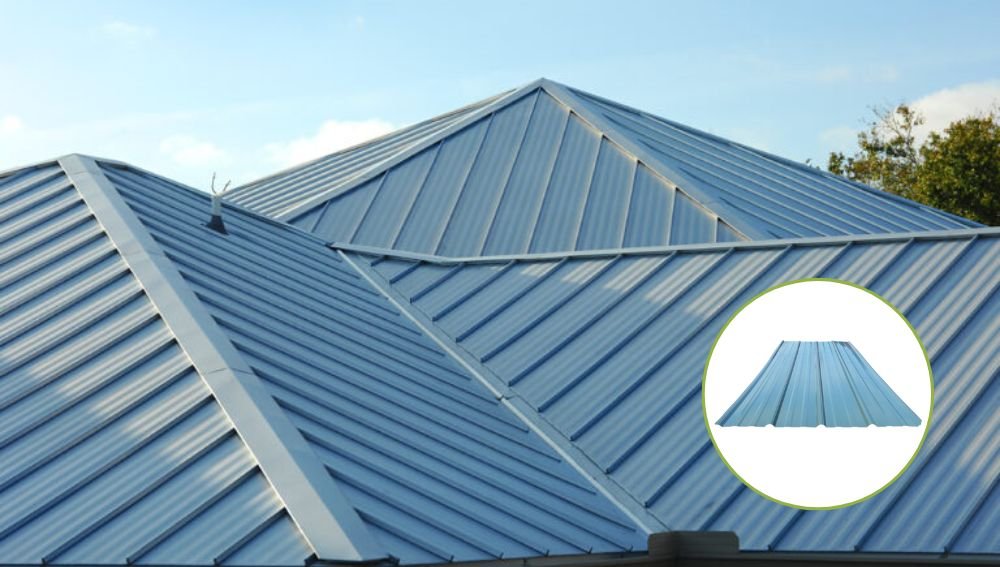
The metal roofing manufacturing process often involves various steps1. Here is a general overview:
Raw Material Procurement: The first step is to get the raw materials needed for manufacturing metal roofing. It may include pre-painted coils of strong roofing metal. You can store them in a temperature-controlled setting.
Cutting and Shaping: Cut the metal coils and shaped them into specific sizes and profiles according to the desired design. Use these metal coils using specialized machinery and tools.
Coating Application:
Coat the metal panels with a protective layer to enhance durability and resistance against corrosion. Apply different coating options, like paint or zinc to the board panels.
Forming and Stamping:
The shaped metal panels go through a forming and stamping process, pressing and molded into the desired shape and profile. Perform these tasks using high-tonnage stamping presses.
Finishing Touches:
The metal panels may undergo extra processes for aesthetic appeal and functionality. These panels can include:
- Adding texture
- Embossing patterns
- Applying special coatings for heat resistance or energy efficiency
Quality Control: Throughout the manufacturing process, quality control measures are in place. It ensures the metal roofing products meet the required standards. It includes rigorous inspections, testing, and adherence to industry regulations.
Produce metal roofing systems with reliable building protection and durability with these steps.
Build metal panels with an air gap between two surfaces for insulation as part of the wall system’s design. The air gap insulation can provide the following:
- Added protection against moisture and air infiltration
- Improve the thermal performance of the panel
- Reduce the transmission of sound, depending on the design
Yet, using an air gap depends on specific factors such as the building design and the insulation material. While some metal panel systems include air gap insulation as part of their design, not all metal panels come with this feature.
Metal roofing comes in large flat sheets folded across in several patterns. Their categories include:
- Corrugated metals
- Flat seam metal roofing
Flat seam metal roofing can be more expensive to make and install, but its interlocking seam design is among today’s best options.
Secure a smooth metal surface to the roof frame beneath interlocking seams. Fasten them with them strength and durability while requiring minimal maintenance.
Nearby in material but a decade or two behind in design are the following materials:
- Corrugated Steel
- Aluminum
- Tin
- Composite Metals
You can buy them from many lumber retailers across the country. Corrugated metals are also folded across in a pattern of repeating spacing. Attach them to the underlying roof structure with nails or screws fitted with rubber washers as gaskets at the attachment points.
Advantages and Disadvantages of Metal Roofing Vs. Asphalt Shingles
Metal Roofing Advantages
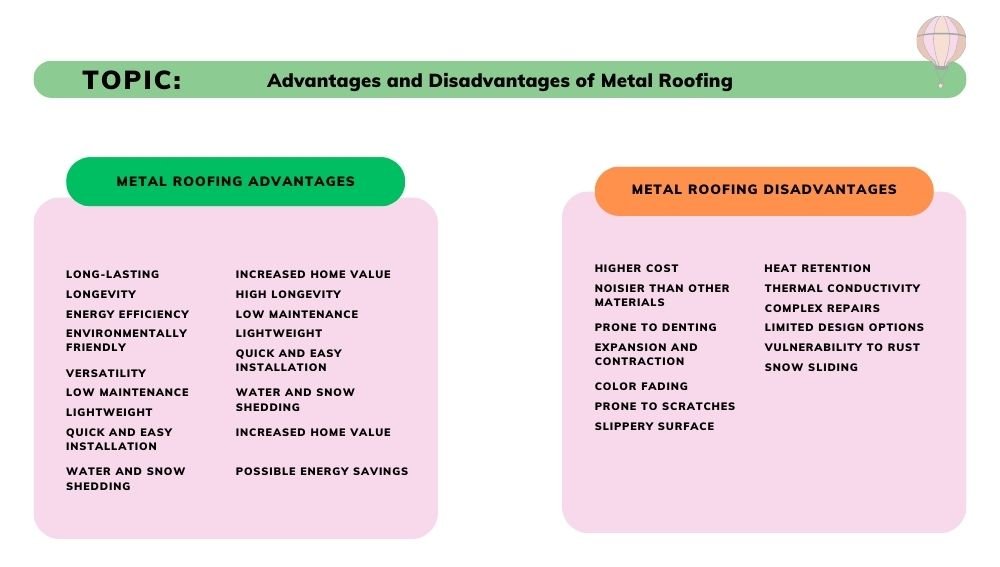
- Long-lasting: Roofers know metal roofing for its exceptional durability. Steel roofing is not vulnerable to extreme weather events such as high winds, heavy snowfall, or hailstorms. Apart from being fire resistant, metal roofs are also resistant to rot and insects.
- Longevity: Metal roofing has a long lifespan compared to other roofing materials. It can last 50 years or more with proper installation and maintenance, reducing the need for frequent roof replacements.
- Energy Efficiency: Metal roofing has excellent energy-efficiency properties. Through heat reduction, it is possible to save a great deal of energy over time.
- Eco-Friendly: Metal roofing is sustainable and a good choice for the environment. Despite its high recycling rate and indefinite potential for reuse, it maintains its performance properties. Metal roofing reduces the amount of waste generated from roof replacements. It promotes energy conservation.
- Versatility: Metal roofs come in various:
- Styles
- Colors
- Finishes
allowing homeowners to find a design that matches their aesthetic preferences. It’s even possible to have a metal roof that looks like wood shakes or tiles and has all the advantages of metal roofs.
- Low Maintenance: Metal roofing requires minimal maintenance over its lifespan. It does not need regular cleaning or treatments and is less likely to develop leaks or must repair than other roofing materials.
- Lightweight: Metal roofing is light, which can be beneficial for the structural integrity of the building. Achieve increasing design flexibility and prevent damage. Reducing stress on the underlying structure.
- Quick and Easy Installation: Metal roofing is quick and easy to install, saving time and labor costs. It often comes in large sheets or panels you can fit and secure into place.
- Water and Snow Shedding: Metal roofing has a smooth, slippery surface that allows rainwater and snow to slide off. Water doesn’t pond on the roof often, ice dams don’t form, and debris is less likely to accumulate on the rooftop during rainstorms.
- Increased Home Value: The durability, longevity, and energy efficiency of metal roofing can improve the value of a home.
- High Longevity:On average, metal roofs last longer than their counterparts of any other construction material.
- Low Maintenance: Metal roofing requires minimal maintenance over its lifespan. It does not need regular cleaning or treatments and is less likely to develop leaks or must repairs than other roofing materials.
- Lightweight:Metal roofing is a kind of light, which can be beneficial for the structural integrity of the building. Achieve increasing design flexibility and prevent damages. It reduces the stress on the underlying structure.
- Quick and Easy Installation: Metal roofing is quick and easy to install, saving time and labor costs. It often comes in large sheets or panels you can fit and secure into place.
- Increased Home Value: The durability, longevity, and energy efficiency of metal roofing can enhance the value of a home.
- High Longevity: The lifespan of metal roofs is more significant than any other construction material.
- Chic and Popular
- Possible Energy Savings
Metal Roofing Disadvantages
Before deciding on metal roofing, homeowners should consider the following disadvantages. Here are some of the main disadvantages of metal roofing:
- Higher Cost: One of the most significant disadvantages of metal roofing is its initial cost. There is a price difference between metal roofs and other roofing materials, such as asphalt shingles and clay tiles. A metal roof installation may also must professional expertise, which makes the final price higher.
- Noisier than Other Materials:
- Some homeowners may find metal roofing louder than other materials. It happens especially during heavy rain or hailstorms.
- While adding insulation can help reduce noise levels, raindrops hitting metal roofing can still be more noticeable than with other materials.
- Prone to Denting: Metal roofing can be susceptible to denting if hit by large hailstones or heavy objects. Even though denting does not affect the roof’s performance, it can decrease its resale value. It can also impact the top’s appearance.
- Expansion and Contraction: Metal roofing tends to expand and contract with temperature changes. In extreme temperature fluctuations, the constant expansion and contraction of the panels can place stress on the fasteners and joints. It leads to loosening and potential leaks over time.
- Color Fading:
- Some lighter colored metals may experience fading or chalking. It happens after prolonged exposure to sunlight.
- This fading can lead to changes in the roof’s appearance, which some homeowners may find less attractive.
- Prone to Scratches:
- Metal roofing can be vulnerable to scratches during installation or maintenance.
- While minor blemishes do rarely impact the function of the roof, they may be more noticeable in particular metal finishes or colors.
- Slippery Surface: Metal roofing can be tricky when wet or covered in snow or ice. The homeowner may be at risk if they need to access the roof for maintenance or repairs.
- Heat Retention: Metal roofing can keep heat when exposed to direct sunlight for extended periods. The interior of the building can become warmer if it is in a warm climate. Using insulation during installation can cut heat transfer and improve energy efficiency.
- Thermal Conductivity:
- Thermal conductivity is a disadvantage of metal roofing because metals are good heat conductors.
- The heat transfer characteristic of metal roofs makes them vulnerable to extreme weather conditions.
- During hot weather conditions, metal roofing can absorb heat. It transfers that heat inside the building and make it feel hot and uncomfortable.
- This heat can lead to higher energy bills as cooling systems would need to regulate temperature.
- Metal roofs can lose heat during cold weather conditions, resulting in higher energy bills for heating systems.
- In buildings with poor insulation, this can be particularly problematic.
- Complex Repairs: If a metal roof needs repair, it can be more challenging and time-consuming than other roofing materials. Due to the need for special tools and expertise, metal roofing repairs are often expensive.
- Limited Design Options: Metal roofing offers a range of design options, but the choices may not be as extensive as other roofing materials. These options can be a limitation for homeowners seeking specific:
- Shapes
- Textures
- Colors
that may not be available in metal roofing.
- Vulnerability to Rust:
- While metal roofing is generally corrosion-resistant, certain metals, such as steel, may be prone to rust.
- It happens when they don’t get a good maintainance or if the protective coating has damages.
- Preventing rust and extending the roof’s lifespan is possible with routine inspections and prompt repairs.
Snow Sliding: Metal roofing has a smooth surface, which can cause snow to slide off the roof. The result may be the formation of snow avalanches, damaging properties, or posing a danger to those below. Install snow guards or other snow retention systems to prevent this issue.
Asphalt Shingles Advantages
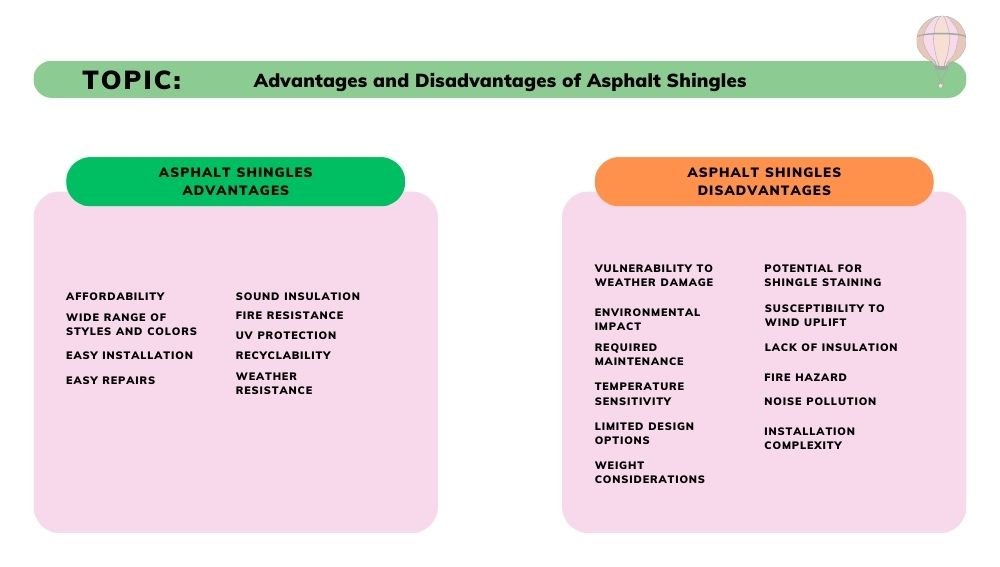
Homeowners can make an informed decision that fits their budget and needs. Proper installation and maintenance can also help lower or avoid these disadvantages altogether.
Asphalt Shingles Advantages
Listed below are some of the advantages of asphalt shingles:
Affordability: Many homeowners select asphalt shingles as one of the most budget-friendly roofing options. They offer adequate roof protection at reasonable prices.
Wide Range of Styles and Colors:
Choosing shingles matching a homeowner’s aesthetic preference is easy with asphalt shingles. They are available in many styles and colors. Whether you prefer the look of:
- Traditional three-tab shingles
- Dimensional appearance of architectural shingles
there is a style to suit every taste.
Easy Installation:
- Asphalt shingles are often easy and quick to install.
- It can help reduce labor costs.
- Roofing contractors can easily install them using standard roofing tools and techniques. They come in standardized sizes.
- Used as asphalt shingles for all shapes and sizes of buildings.
- They are perfect for many architectural styles.
- It is possible to install them both on residential and commercial properties.
Weather Resistance: Manufacturers design asphalt shingles to withstand various weather conditions. These features help the shingles hold up well against storms, high winds, and algae or moss growth.
Easy Repairs: In the event of damage or wear, individual asphalt shingles are often easy and inexpensive to repair or replace. Other roofing materials are harder to maintain and restore, so it’s more convenient to use them.
Sound Insulation:
Many layers of asphalt shingles will help to reduce exterior noise from rain and wind. They provide some sound insulation. Indoor environments will be more welcoming and quieter as a result.
Fire Resistance: Asphalt shingles have a class A fire rating, the highest fire resistance rating available. Prevent roof fires with their help as they offer significant fire protection.
UV Protection:
Asphalt shingles offer protection against ultraviolet (UV) rays. They damage roofs and cause damage to the structure. Shingles with granules help reflect UV radiation and prevent premature deterioration.
Recyclability:
- It’s best to repurpose asphalt shingles into other products instead of ending up in landfills.
- When compared to some other roofing materials, asphalt shingles are more sustainable.
- As a result of these features, asphalt shingles are popular and practical choices for homeowners.
- Various designs are available, and they are both reliable and inexpensive.
Asphalt Shingles Disadvantages
- There are a few disadvantages to asphalt shingles:
- Limited Lifespan: Asphalt shingles have a shorter lifespan than other roofing options. They can last 15 to 30 years. Depending on the quality and maintenance, they may need replacement sooner than more durable options.
Vulnerability to Weather Damage:
- Storms
- High winds
- Hail
- Though factories make them withstand extreme weather conditions, shingles can sustain damages. Intense heat can also cause the shingles to deteriorate over time.
Environmental Impact:
- The production and disposal of asphalt shingles can have an ecological impact. The asphalt manufacturing process releases greenhouse gases. They come from petroleum, an unrenewable resource.
- Required Maintenance: Needs regular maintenance for asphalt shingle roofs to ensure longevity. Inspecting the roofing shingles for damage, such as cracking and curling, may be necessary. Clean the surfaces often to prevent debris from building up or the growth of algae and moss.
- Temperature Sensitivity: Temperature fluctuations affect asphalt shingles. It is usual for them to crack and warp when exposed to high temperatures for an extended period. Exposure to colder climates, ice dams, and freeze-thaw cycles may cause damage.
Limited Design Options:
- Asphalt shingles often have fewer design options than metal or tile roofing materials. Asphalt shingles may offer less flexibility if you have specific aesthetic preferences or want a unique roof design.
Weight Considerations:
- Asphalt shingles can be heavy compared to alternative roofing materials. Contractors need to reinforce and support roofs and building structures.
Potential for Shingle Staining:
Over time, asphalt shingles may develop unforeseen stains caused by:
- Algae
- Moss Growth
- Air Pollution
- Environmental Debris
- While staining does not affect the performance of the shingles, it can impact the roof’s appearance
Susceptibility to Wind Uplift:
- Asphalt shingle roofs are vulnerable to wind uplift. It’s when the wind gets underneath the edges of the shingles and causes them to lift or even tear off the top. Areas with high wind speeds or frequent storms are particularly vulnerable to this.
- Lack of Insulation: A building’s roof may only provide a little insulation compared to other roofing materials like metal or tile. They may not be suitable for areas experiencing extreme temperatures or fluctuating weather.
Fire Hazard:
- The improper maintenance of asphalt shingles or the presence of flammable materials nearby can cause a fire hazard. A single ember from a nearby fire can ignite the shingles, leading to potential damage or danger.
Noise Pollution:
- Asphalt shingle roofs can create significant noise pollution inside the building in areas with frequent rain or hail. The lack of a soothing peace may not be a severe problem for some, but it can be a problem for others.
Installation Complexity:
- It may be easier to install some roof materials. But asphalt shingles need a more labor-intensive and time-consuming installation process.
- Using your home’s equity is an easy way to fund your new roof!
- Get prequalified in minutes by clicking on your state.
- Learn More
Types of Asphalt Shingles
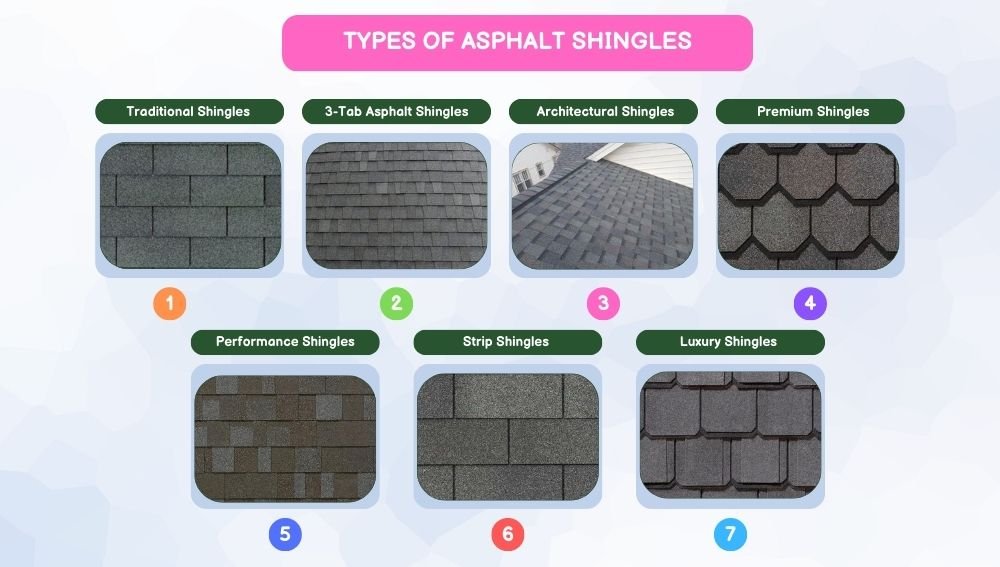
- There are several types of asphalt shingles available for roofing. Some common types include:
- Traditional Shingles are the most basic and standard type of asphalt shingles. They are flat and uniform.
3-Tab Asphalt Shingles:
- These 3-Tab asphalt shingles are an essential and affordable roofing option. They consist of a single layer of asphalt with three tabs. Budget-conscious homeowners prefer them because they have a uniform appearance and are easy to install.
Architectural Shingles:
- They are also known as dimensional or laminate shingles. Architectural shingles have a layered, multidimensional design. They often mimic the appearance of slate or wood shakes, providing a better visual and textured appealing look to the roof.
Premium Shingles:
- Premium shingles are high-end asphalt tiles with enhanced durability, aesthetics, and performance. It can resemble high-end materials like slate, tile, or shake shingles at a lower cost.
Performance Shingles:
In contrast to traditional tiles, performance shingles stand up to adverse weather, including:
- High Winds
- Heavy Rain
- Hail
- Manufacturers design performance tabs to endure impact, wind currents, and algae. Engineer these parts for enhanced resilience.
Strip Shingles: Strip shingles are a primary type of asphalt shingle that consists of a single layer. Batteries of this type may have less life than other types, despite their light weight and affordability.
Luxury Shingles: They are a premium-grade type of asphalt shingle. It offers an upscale appearance and improved durability. A thicker profile and enhanced color blends are often features of these products.
- Different manufacturers may have variations and proprietary names for their asphalt shingle products. Learn more about asphalt shingles in your area. Consult a roofing professional or check manufacturer specifications.
Which Roofing Material Is Best?
What roofing material is suitable for a home depends on a host of factors, including:
- Cost
- Maintenance Requirements
- Lifespan
- Climate
- Environment
Roofing materials play a crucial role in ensuring the building’s:
- Longevity
- Safety
- Energy Efficiency
- Curb Appeal
What Criteria are Relevant for Choosing the Correct Roofing Materials?
You must select rooftop components based on the following factors when designing a particular project:
Roofing Longevity: There is a significant impact on the sturdiness and helpful life of a roof in its manufacturing process. You should choose the right roofing components. It ensures your rooftop lasts many years without problems and maximizes your investment.
Some of these materials include:
- Composite Shingles – 20-30 years
- Wood Shake or Shingles – 30-40 years
- Standing-Seam Metal or Corrugated Metal – 40-70 years
- Clay or Concrete Tiles – 50-100 years
- Slate Roofing – over 100 years
Roof Cover Safety Protection: Some of these materials include:
- Metal Roofing
- Tile Roofing
- Slate Roofing
- Synthetic Roofing
Rooftop Energy Efficiency:
A suitable roofing material can impact a building’s energy efficiency. A light-colored or reflective roofing material reflects solar heat. It also reduces cooling costs during hot weather. In contrast, a darker roofing material may help keep heat and lower heating costs in cold weather. Here are some recommended materials:
- Metal Roofing
- Asphalt Shingles
- Clay and Concrete Tiles
- Synthetic Roofing
Roofing Curb Appeal:
The roof of a building plays a significant role in its appearance and curb appeal aesthetics. Enhance a building’s aesthetics with suitable roof material, whether a house or a business.
Several roofing materials can enhance the curb appeal of a home or building. Here are some options to consider:
- Natural Stone Slate Roofing Offers a Unique and Attractive Look
- Clay Tiles Adds Elegance
- Metal Roofing Gives Buildings a Modern and Sleek Look
- Synthetic Roofing Mimic The Look of Slate, Clay, and Wood Materials
Other Types of Roofing Materials
Different roofing supplies are available for different types of roofs. Other products differ in their long-term performance, appearance, cost, and serviceability. Roofing options vary from:
Traditional like:
- Asphalt shingles
- Metal roofing
To more modern alternatives like:
- Synthetic materials
- Green roofing
- Roofing Tile Materials
- Plastic Roofing Materials
- Rubber Roofing Materials
- Sustainable Roofing Materials
Roofing Tile Materials
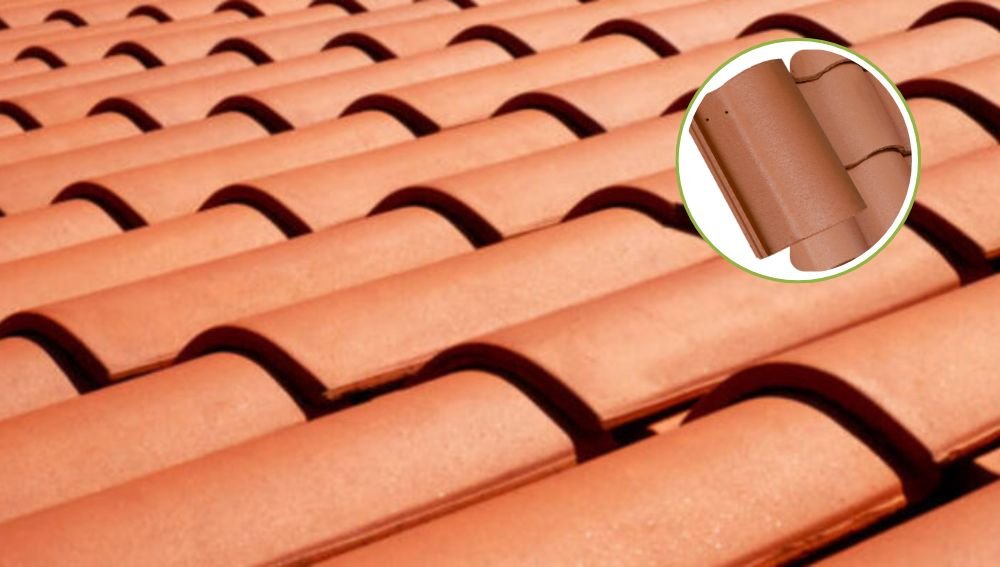
As a result of their:
- Strength
- Timeless Aesthetic
- Long-lasting performance
Roof tile types vary from one type to another, each having advantages and disadvantages.
Clay Tiles: Roofers have used clay tiles for centuries. We know them for their classic and elegant appearance. Kilns bake the tiles by forming natural clay into tiles and then baking them. A clay tile can withstand harsh weather conditions, is sturdy, and is fire-resistant. Complement their thermal insulation properties with their cooling properties in the summer.
Concrete Tiles: Water, cement, and sand are the ingredients that go into making concrete tiles. Fire, wind, and hail cannot damage them, either.
Slate Tiles: Manufacturers make slate tiles from natural stone. They regard them for their beauty and durability. Slate tiles have longevity and can last a century or more with proper maintenance. Fire, moisture, and insects love them because of their low maintenance requirements.
Composite Tiles: Composite tiles are a more modern alternative. They combine different materials to create a durable and affordable roofing option. They consist of recycled materials, such as:
- Plastics
- Rubber
with additives enhancing stiffness and endurance.
They are often more affordable and lighter than other roofing materials. Composite tiles mimic the appearance of different roofing materials.
Metal Tiles: Metal tiles, such as those made from steel or aluminum, offer a unique and contemporary aesthetic for roofing.
Selecting roofing tile components depends on several factors, including:
- Budget
- Climate
- Architectural style
- Customer taste
Plastic Roofing Materials
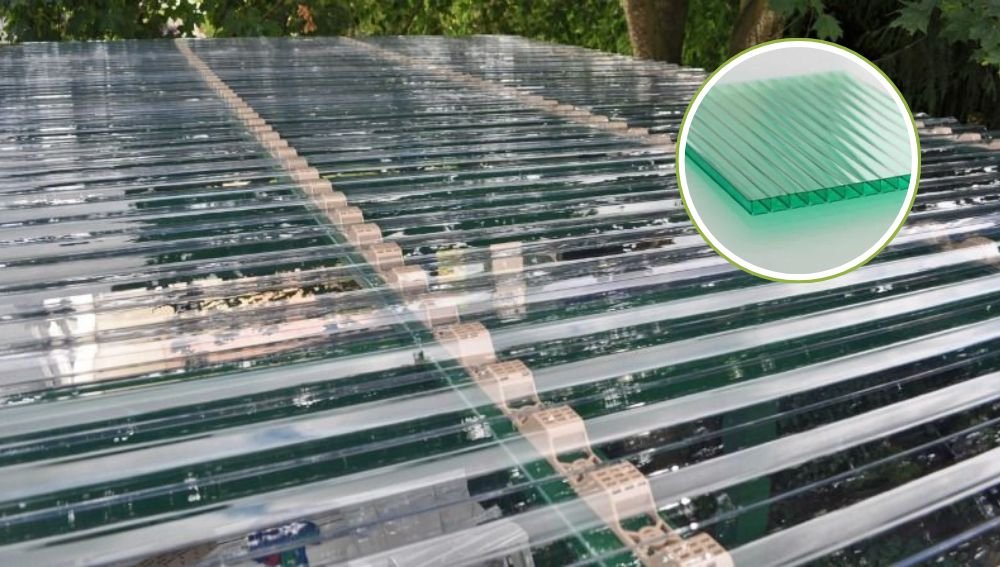
Homeowners and commercial building owners can enjoy plastic roofing materials. These are versatile and affordable. Made from a variety of different plastics, including:
- Polycarbonate
- PVC
- Acrylic
And often come in the form of:
- Panels
- Sheets
- Tiles
You can mount it with ease using traditional roofing techniques.
Plastic Roofing Components Benefits
Lightweight: Plastic roofing materials are easy to move. They are easy to install and remove during maintenance or repair work.
Long Lasting: Plastic roofing materials are often highly resistant to damage from:
- Weather
- Fire
- UV Radiation
This sturdiness means they can last for many years with low maintenance.
Versatile: Plastic roofing products offer a wide range of design options, including:
- Different colors
- Patterns
- Textures
They can mimic the appearance of other roofing materials, such as clay or metal, at a fraction of the cost.
Energy Efficient:
Manufacturers design plastic roofing materials with energy efficiency in mind. They provide adequate insulation to keep homes or buildings cool in the summer and warm in the winter.
Plastic Roofing Elements Drawbacks
Vulnerable to Damage:
While plastic roofing products are durable, they are prone to cracking or breaking in freezing temperatures. They may also warp or crack over time due to UV radiation.
Limited Lifespan:
Plastic roofing materials may not last as long as other materials like tile or metal. It makes them less suitable for long-term roofing solutions.
Poor Noise Insulation:
Plastic roofing materials are less effective at insulating sound than other materials. It leads to potential higher noise levels during heavy rain or hail periods.
Reasonable prices and exceptional service are why plastic roofing materials exist. Interested parties are homeowners and commercial enterprises. Yet, as with roofing materials, you should consider the pros and cons with care before investing. Plastic roofing elements are only suitable for some roofing needs and budgets. It is crucial to consult a professional roofing contractor or manufacturer before deciding.
Synthetic Roofing Materials
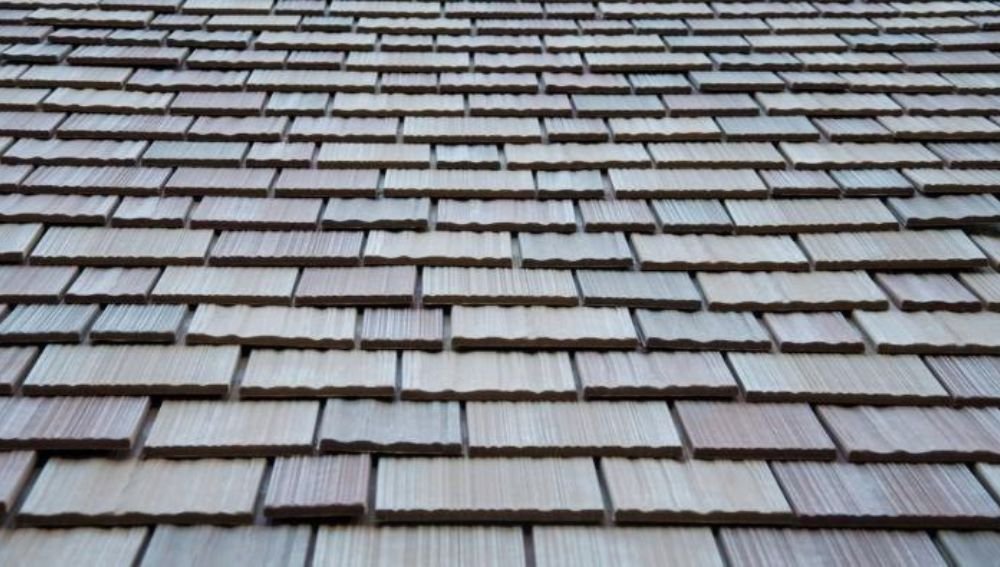
Synthetic roofing materials have similar appearance and performance to natural roofing, such as:
- Slate
- Shake
- Spanish tile
Their main components are plastic and rubber materials. Replicating the look of raw materials, synthetic roofing provides homeowners with:
- An affordable
- Lightweight
- Eco-friendly alternative
Manufacturing synthetic roofing materials involves plastic and rubber materials. These components are often recycled or made from virgin resins. Mold or shape these materials to resemble the textures and shapes of natural roofing materials. It results in a roof that mimics the look of traditional roofing materials. It is resilient and long-lasting.
One popular type of synthetic roofing material is synthetic slate. It offers the same elegant and sophisticated appearance as natural slate. But at a lower cost and with added benefits such as increased durability and resistance to weathering. Manufacturers often blend plastic and rubber materials to make synthetic slate roofing.
Synthetic shake is another type of synthetic roofing material. It replicates the look of authentic wood shakes. But it avoids the drawbacks associated with wood, such as susceptibility to rot and insects. Factories often make synthetic shake roofing materials from a combination of plastic polymers. Designed to mimic the natural wood shake appearance.
The benefits of synthetic roofing materials include their:
- Lightweight nature
- Ease of installation
- Cost-effectiveness
compared to their natural counterparts. Additionally, artisans often design synthetic roofing materials to be highly resistant to:
- Weathering
- Fire
- UV Radiation
They make long-lasting and low-maintenance options for property owners.
It’s relevant to consult with roofing professionals or manufacturers. Determine the specific advantages and drawbacks of different synthetic roofing materials. It includes their composition, and performance may vary. Artificial roofing elements offer house owners an attractive and sustainable alternative. This is in comparison to natural roofing with extra benefits.
Rubber Roofing Materials
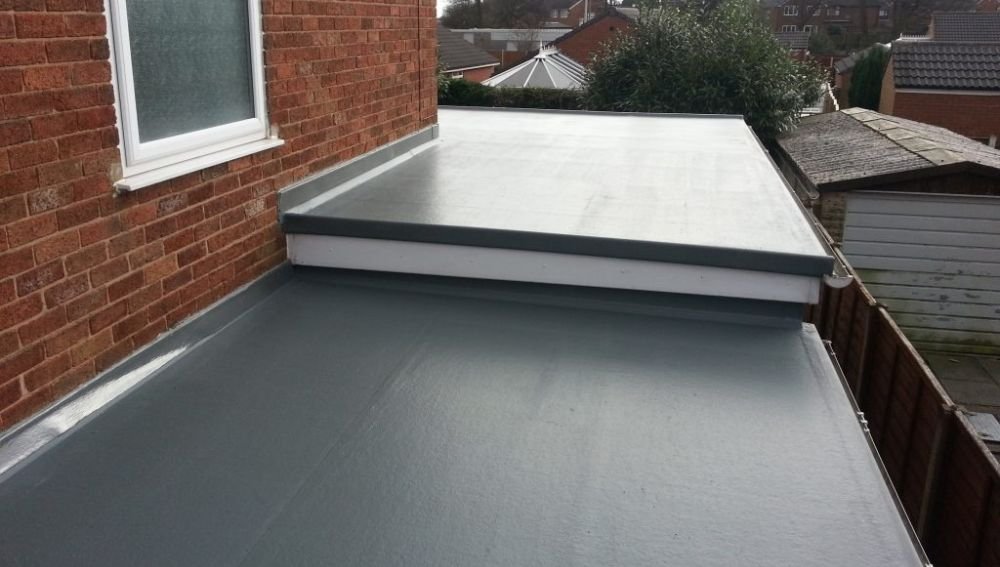
Rubber roofing materials, also known as EPDM (ethylene propylene diene terpolymer), have become a durable and cost-effective option. These materials apply to residential and commercial roofs. Factories make this type of roofing compound from synthetic rubber compounds. It offers a variety of benefits and advantages.
Here are some critical points about rubber roofing materials:
Rubber Roofing Benefits:
Durability:
Rubber roofing materials resist harsh weather conditions like:
- UV radiation
- Extreme temperatures
- Hail
They can withstand expansion and contraction without cracking. They make them ideal for regions with fluctuating climates.
Leak Resistance:
EPDM roofs have heat-welded or chemically adhered seams. They result in a seamless, watertight roofing system. It reduces the risk of leaks and water damage.
Low Maintenance: Rubber roofing requires minimal maintenance. It is resistant to:
- Mold
- Mildew
- Algae Growth
And you can clean them easily with the following:
- Water
- Mild Soap
Long Lifespan:
When properly installed and maintained, rubber roofs can last for 30 years or more. It makes these roofs an affordable option over the length of their life.
Energy Efficient: Rubber roofing materials have excellent heat and cold insulation properties. They can help reduce energy consumption by:
- Keeping the building cooler in hot weather
- Retaining heat during cold weather
Rubber Roofing Drawbacks:
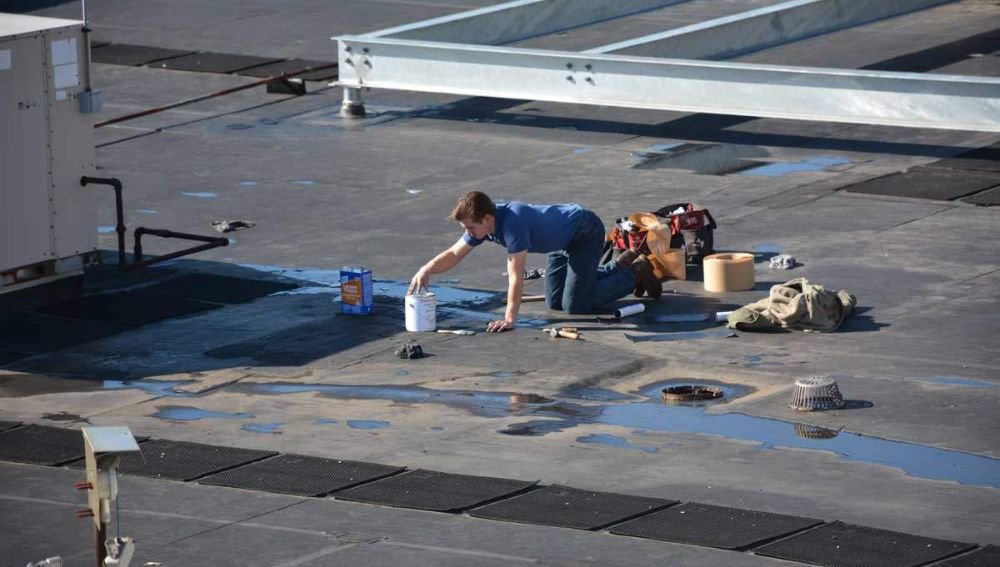
Installation Complexity: Installing rubber roofing requires:
- Professional expertise
- Specialized techniques
Especially when it comes to large commercial roofs, improper installation can:
- Compromise the performance
- The lifespan of the roof
Environmental Impact:
While manufacturers make rubber roofing from recycled materials, others have a higher ecological impact. This is due to the energy-intensive manufacturing process. Yet, EPDM roofs are often recyclable at the end of their lifespan, reducing waste.
Limited Color Options:
Rubber roofing materials often come in black or dark gray colors. This is a limiting factor for aesthetic options for customers who prefer a more comprehensive range of roof colors.
To sum up, rubber roofing materials provide:
- A durable
- Low-maintenance
- Cost-effective solution
. . .for both residential and commercial roofs. They are perfect for a reliable, robust roofing system with excellent weather tolerance. Yet, professional installation is crucial to ensure optimal performance and longevity. Consult a roofing professional to assess whether rubber roofing suits your requirements.
Sustainable Roofing Materials
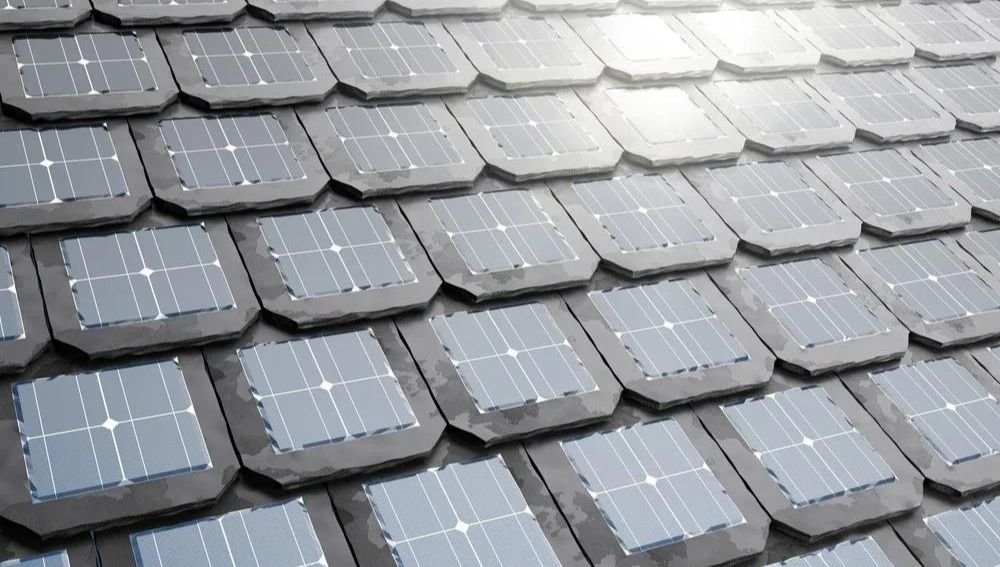
Roofing elements manufactured from sustainable materials are gaining popularity. These are green-minded consumers seeking alternatives. They want to lower their carbon footprint and promote sustainability. These materials focus on:
- Resource conservation
- Reduced energy consumption
- Reduced greenhouse gas emissions
They design these elements with sustainability principles in mind. Here are some notable sustainable roofing components:
- Metal Roofing:
Metal roofing is a highly sustainable option due to its:
- Long lifespan
- Recyclability
- Energy efficiency
Metal roofs are:
- Often made from recycled materials
- Recycled again at the end of their lifespan
- Helping reduce waste
Reflecting solar heat and being able to install over existing roofs, they reduce:
- Cooling costs
- Waste disposal costs
- Solar Tiles:
Solar tiles, known as solar shingles, provide:
- A dual benefit by serving as:
- Roofing material
- Generating renewable energy
- These tiles are:
- Designed to integrate a seamless roof:
- Providing aesthetic appeal while
- Harnessing the power of the sun
- Solar energy collected from the tiles can:
- Be used to power the building
- Sold back to the grid
- Promoting Sustainability
- Reducing Energy Costs
- Vegetative Roofs:
Covered roofs with living vegetation are vegetative roofs, often called green roofs. These roofs provide:
- Insulation
- Absorb Rainwater
- Improve air quality
- Create a habitat for:
- Plants
- Insects
Vegetative roofs:
- Reduce the urban heat island effect
- Regulate temperature
- Decrease stormwater runoff
They can be:
- Extensive (with low-growing plants)
- Intensive (with more diverse vegetation and even recreational areas)
- Recycled Shingles:
Recycled shingles often resemble conventional roofing materials. Created from a blend of post-consumer trash, such as plastic or rubber. Need direct waste from landfills and no fresh resources for these tiles. Eco-friendly, resilient, weather-resistant, and attractive, they can lower harmful environmental effects.
- Clay Tiles:
Used for centuries and renowned for their toughness and lifespan are clay tiles. They offer high insulation and ventilation as a natural clay material, so you will not need to heat or cool the room as much. When clay tiles reach the end of their useful life, they are often recyclable, and you can use them again.
- Chill Roofs:
Cool roofs reflect the sunshine and absorb less heat, which lowers the energy required to chill the structure. Use high solar reflectance materials like light-colored coatings. Also, use specialized tiles to create them. Reduce urban heat islands by using cool roofs, and increase energy efficiency.
People may help protect the environment. Use less energy, and make their homes more nature friendly by selecting sustainable roofing materials. Thoroughly inspect materials and installation methods to ensure they follow local requirements. Speaking with sustainable design and installation experts is crucial. When you consider sustainable roofing solutions, call the experts.
Specific Roofing Needs: Special Considerations
Building owners and managers must consider several elements when it comes to specialized roofing requirements to ensure the durability and effectiveness of the roofing system. Here are a handful of the most typical things to think about:
- Climate: Building climate affects the roofing system’s design and the selection of roofing materials. High wind and rain zone structures may need a more durable roofing system. Still, facilities in high heat zones might benefit from a ventilated roofing system that helps lower energy expenses.
- Structure-function: The structure’s type and function will also determine roof requirements. For instance, to protect against damage from water infiltration or freezing temperatures, buildings that store sensitive equipment or materials may require a roofing system with high insulation and weatherproofing.
- Roof Traffic: The kind of roofing system required can vary depending on the foot traffic on a roof. A roof with little to no foot activity may not need as strong roofing material as one with frequent foot traffic, such as a rooftop patio.
- Roof Slope and Drainage: A roof’s slope and drainage features are important considerations when constructing a roofing system. The slope must be suitable to provide proper drainage and prevent water from standing on the roof. Employ particular care while installing and maintaining drainage systems on flat rooftops.
- Architectural Style: Consider one crucial aspect: architectural style. The roofing type should blend well with the building’s overall design aesthetics and provide a pleasing, unified appearance.
- A roofing design complements a structure’s historical aspects with a traditional architectural style, such as Colonial, Victorian, or Tudor, is advantageous. These roofing materials could be shingle, slate, tile, or metal roofing with a visual appeal that satisfies the building’s design requirements. On the other hand, a structure with a modern architectural style would require a roofing style that reflected this approach style, with clean lines and a minimalist design. This building might benefit from a flat or low-sloped roofing system constructed of PVC or TPO materials.
- Budget Considerations: The budget is one of the critical factors to consider when selecting a roofing material. Choosing the roofing material that may satisfy budgetary needs while meeting aesthetic and functional criteria is essential. Using asphalt shingles, which are relatively simple to install and provide several design options, is one economical roofing method. The average lifespan of metal roofing is 50 years, and it has minimal maintenance costs and excellent energy efficiency, all of which can improve return on investment. The complete cost of installation, including personnel, supplies, and any additional demands depending on a building’s particular roofing requirements, should be considered when creating a budget. Obtaining various roofing quotations also aids in determining the best value.
- Prioritize the features and specifications that are most crucial when thinking about the budget for a particular roofing project, and try to discover the material that best satisfies those objectives within the allocated spending limit.
- It’s important to consider all the variables affecting the structure and its intended use to meet unique roofing needs. Increase a roofing system’s lifetime, efficacy, and performance with careful consideration of these elements.
When deciding between metal roofing and asphalt shingles, here are some tips for picking the best roofing material.
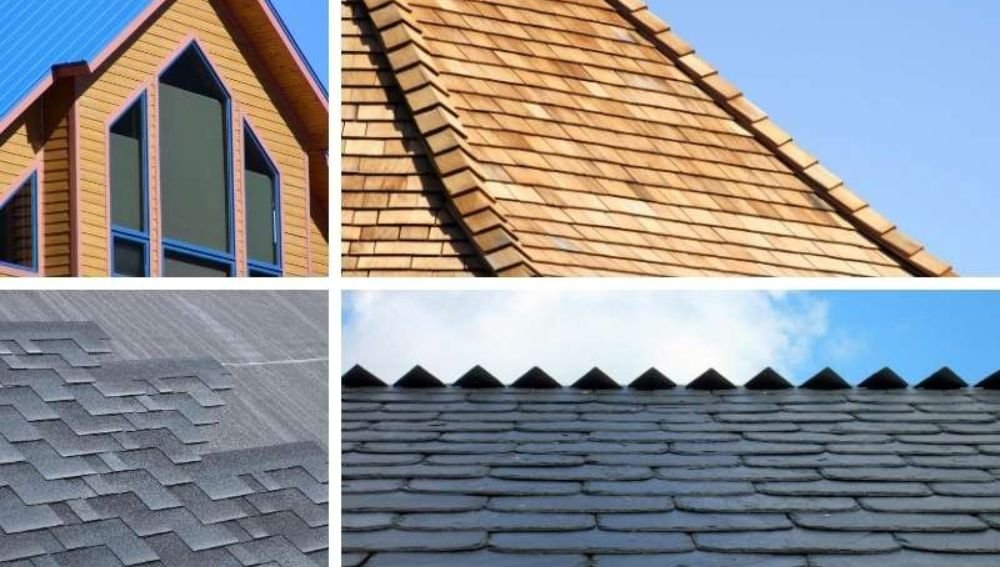
Evaluate a few crucial aspects while deciding between metal roofing and asphalt shingles. Making an informed decision may require consulting with a qualified roofing contractor.
- Durability and longevity: Compared to asphalt shingles, metal roofing has a longer lifespan, frequently lasting 50 years or more. Due to its robustness, it is a wise long-term investment. Conversely, asphalt shingles typically have a lifespan of 20 to 30 years. Consider the roof’s expected lifespan and how it fits with your long-term goals for the structure.
- Climate compatibility: Depending on the climate, various roofing materials perform differently. High winds, a lot of rain, and hail are all things that metal roofing is quite resistant to. They are suitable for places vulnerable to wildfires because they are also fire-resistant. Due to their greater susceptibility to weather-related deterioration, asphalt shingles may need more frequent maintenance or replacement.
- Energy effectiveness: Metal roofing is known to be energy efficient since it reflects solar heat, which lowers cooling costs in hot regions. On the other side, asphalt shingles absorb heat, raising the energy needed for air conditioning. Think about your roofing material’s environmental impact and energy efficiency goals.
- Aesthetics and architectural design: Both asphalt shingles and metal roofing come in various designs and colors. Please take into account the architectural design of your building and how each roofing material will enhance it. While asphalt shingles might be more appropriate for conventional or historic forms, metal roofing can improve the appearance of modern or contemporary architecture.
- Cost factors: Metal roofing often costs more upfront than asphalt shingles. However, because metal roofing requires less upkeep and has a longer lifespan, it is crucial to consider long-term cost savings. Consult a roofer who can provide you with installation and upkeep costs and pricing estimates for both solutions.
- Consult a qualified roofing contractor: Professionals strongly advise that you speak with a qualified roofing contractor who can evaluate your structure, consider your unique requirements and spending plan, and give knowledgeable advice. To assist you in selecting the finest roofing material for your project, they can assess variables, including roof structure, slope, and local building codes.
- Overall, working with a qualified roofing contractor is crucial to ensuring the material you select will satisfy your unique requirements, considering things like durability, climate compatibility, energy efficiency, aesthetics, and economic considerations. They may offer advice and assist you in making the best roofing material selection for your structure.
Which is superior, asphalt shingles or metal roofing?
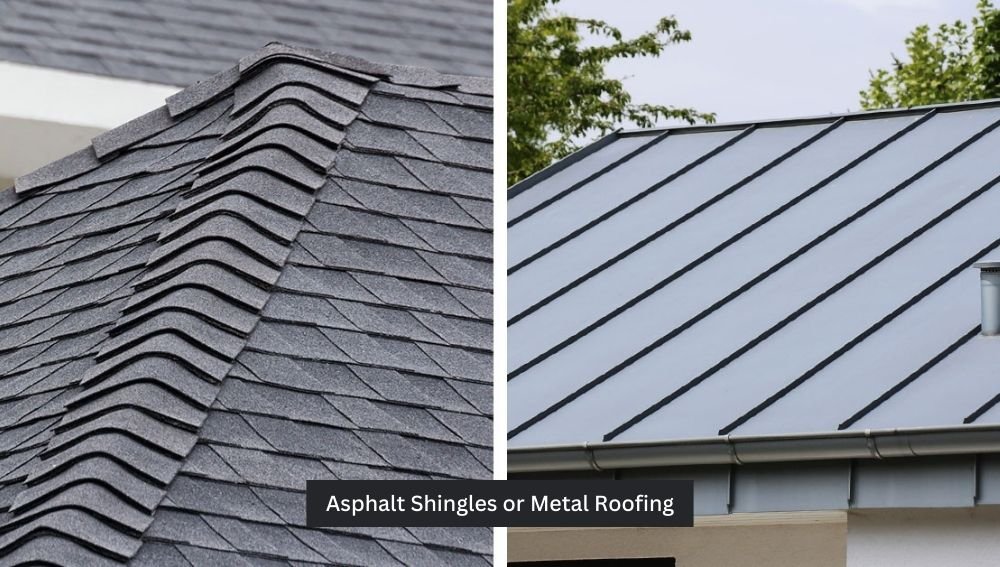
It’s critical to comprehend the advantages and disadvantages of each roofing material when contrasting metal roofing and asphalt shingles. It’s important to remember that the decision ultimately comes down to personal preferences and needs. Outline the benefits and cons of each type of roofing material below:
- Longevity: Metal roofs have a longer lifespan and can survive, on average, for 50 years or more.
- Durability: They can withstand harsh weather conditions like hail, strong winds, and rain.
- Energy Efficiency: In warmer climates, metal roofs reflect solar heat, lowering cooling costs.
- Low Maintenance: They need little upkeep and are less likely to sustain harm.
- Cons of Metal Roofing: Higher Initial Cost Metal roofing often costs higher than asphalt shingles.
- Metal roofs may be noisier during heavy rain or hail periods if you don’t install the correct insulation.
- Aesthetics: Metal roofs come in various colors and styles, but they might need to look better with classic or old-style architectural designs.
Advantages of Asphalt Shingles:
- Lower Initial Cost:
- When compared to metal roofing, asphalt shingles are less expensive.
- They are relatively simple to install, which lowers labor costs.
- Aesthetics: Asphalt shingles are available in a wide range of designs and hues that go well with different types of architecture.
- Repairability: Individual shingles can be changed if they are damaged.
- Cons of Asphalt Shingles: Shorter Lifespan: Since asphalt shingles typically only last 20 to 30 years, you don’t need to replace them more frequently.
- Weather Susceptibility: They may be vulnerable to damage from extreme weather.
- Asphalt shingles absorb heat, increasing the energy needed for cooling.
- Upkeep: As time passes, they need additional care, such as routine inspections and repairs.
When deciding between metal roofing and asphalt shingles, it’s crucial to consider several aspects, including cost, energy efficiency, aesthetics, climate compatibility, durability, and longevity. A qualified roofing contractor can help you choose the best option for your roofing project. They can evaluate your unique needs, financial situation, and regional requirements.
Metal Roofing Maintenance and Care
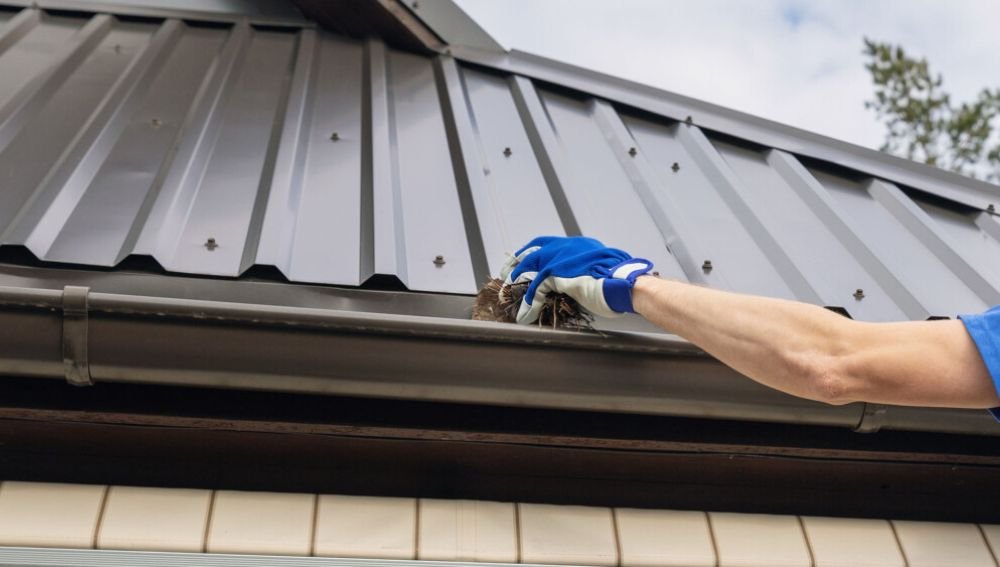
Proper maintenance and care are essential to keep your metal roofing in optimal condition and extend its lifespan. Metal roofs are known for their durability and low maintenance requirements, but regular upkeep can help prevent issues and ensure their long-term performance. Here are some critical tips for metal roofing maintenance and care:
- Regular Inspections: Conduct routine inspections of your metal roof to identify any signs of damage or wear. Check for loose or damaged panels, fasteners, rust spots, or any other issues requiring attention.
- Clean the Roof: Remove any debris, leaves, branches, or other materials accumulating on the roof. Use a soft-bristle brush or leaf blower to clean the surface gently. Avoid using harsh chemicals or abrasive tools that could damage the roofing material.
- Clear the Gutters: To ensure proper water flow and drainage, keep the gutters and downspouts clear of debris. Clogged drains can lead to water backup and potential damage to the roof.
- Address Tree Overhangs: Trim any branches or foliage that hang over the roof. Falling branches or rubbing against the top during strong winds can cause damage to the metal panels or coatings.
- Prevent Ice Dams: Take steps to prevent ice dams from forming in cold climates. Ensure proper insulation and ventilation in the attic to maintain consistent temperatures and to avoid ice from melting and refreezing along the roof edges.
- Repair and Replace Damaged Panels: Promptly address any damaged or loose metal panels. Repair or replace them to maintain the roof’s integrity and prevent leaks or further damage.
- Check Seals and Flashing: Inspect the seals and flashing around vents, chimneys, skylights, or other roof penetrations. Ensure they are in good condition and properly sealed to prevent water infiltration.
- Manage Moss and Algae Growth: If you notice any moss or algae growth on the roof, it’s relevant to address it promptly. Use a mild solution of water and bleach or a specifically designed metal roof cleaner to remove the growth gently. Avoid using pressure washers or abrasive chemicals that can damage the surface.
- Consult with Professionals: If you need clarification on any maintenance tasks or encounter significant issues with your metal roof, it is advisable to consult with professional roofing contractors or manufacturers. They can provide expert guidance and assistance to ensure proper care and maintenance.
By following these metal roofing maintenance tips, you can keep your roof in excellent condition and enjoy its benefits for many years. Remember, regular inspections, cleaning, and timely repairs are vital to ensuring the longevity and performance of your metal roof.
Asphalt Shingles Roofing Maintenance and Care
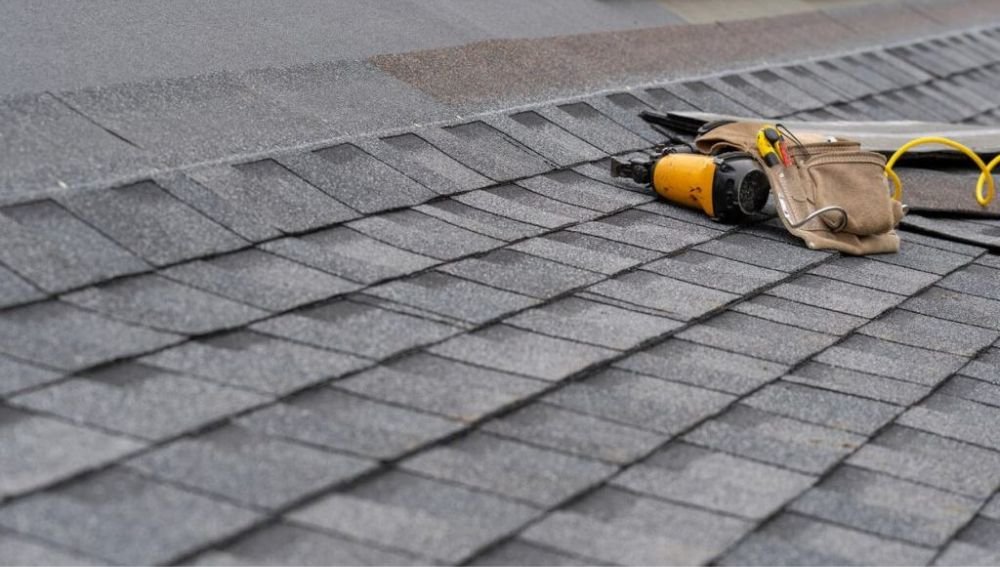
To maintain and care for an asphalt shingle roof, here are some helpful tips:
- Regular Inspections: Schedule regular roof inspections at least once a year to identify potential issues, such as damaged or missing shingles, leaks, or signs of wear and tear.
- Clean Gutters: Keep your gutters clean and debris-free to ensure proper water drainage. Clogged drains can cause water backup, leading to roof leaks and damage.
- Trim Nearby Trees: Trim any overhanging branches or trees near your roof to prevent them from rubbing against or damaging the shingles during strong winds or storms.
- Remove Debris: Remove any leaves, branches, or other debris that accumulates on the roof, as they can trap moisture, promote algae growth, and cause damage to the shingle surface.
- Address Moss and Algae: If you notice moss or algae growth on your asphalt shingles, it’s relevant to address it promptly. Use a mild water and bleach solution or a commercial moss/algae cleaner to wash away the growth gently. Avoid using pressure washers, as they can damage the shingles.
- Prevent Ice Dams: In cold climates, ice dams can cause water to back up under the shingles and lead to leaks. Ensure proper insulation and ventilation in the attic to maintain consistent temperatures and prevent ice from melting and refreezing.
- Avoid Walking on the Roof: Minimize foot traffic on your roof to prevent unnecessary damage to the shingles. If you need to access your roof for maintenance or repairs, use proper safety precautions and consider hiring a professional.
- Promptly Address Repairs: If you notice any damaged, loose, or missing shingles, it’s relevant to address them promptly to prevent water penetration and further damage. Consider hiring a professional roofing contractor for proper repairs.
Regular maintenance and prompt repairs are vital in prolonging the lifespan of your asphalt shingle roof and ensuring its optimal performance. If you have any concerns or are unsure about any maintenance tasks, professionals recommend consulting with a roofing contractor at Innercity Roofers for guidance.
Metal Roofing Lifespan
40 to 70 years—The lifespan of any material will depend on the condition to which it is exposed. But under regular use, expect a metal roof to last more than half a century. Most estimates come in between 40 and 70 years. But as materials continue to improve, expect the lifespan of newer metal roofs to go up, not down.
Asphalt Shingles Lifespan
40 to 50 years—Shingle roofs deteriorate slightly faster than metal roofs. Weather, specifically precipitation and wind, can wear asphalt shingles more quickly, especially if they’ve first had a chance to age in the sun. But as with anything, regular maintenance can help extend the life of your home or project, and replacing shingles and patching roof holes can make all the difference.
Metal Roofing Cost
Metal roofing generally costs a bit more per square foot than asphalt shingle alternatives, sometimes by a magnitude of two or three. Metal roofing typically costs between $8 and $16 per square foot, according to estimates from early spring 2021. Material cost fluctuations will have a more significant impact on the cost of metal roofing.
Asphalt Shingles Cost
Asphalt shingles generally cost between one-third and one-half of what their metal roofing counterparts cost. Typically, a home builder can expect to pay between $2 and $6 per square foot for asphalt shingle roof construction, and shingle costs are not as susceptible to material cost fluctuations as metal options are.
Metal Roofing Installation
Because of the weight and size of metal roofing panels, the installation of this material can be tricky. Please consult a professional contractor and hire him for this job. But serve any DIYers to hire an extra set of hands to help. Most metal roofing systems today have an interlocking edge system. Builders highly advise attention to detail and review of instructions before starting the project.
Asphalt Shingles Installation
Installation is where asphalt shingles win out over pricier metal roofing options, partly because of the cost and challenges of getting metal roofing into place. Shingles were challenging to install, and any roofing contractor or builder will know what to do when working with this material.
Metal Roofing Water, Heat, and Environment
In general, metal roofing is more ventilated in warm climates because the metal will reflect most of the sunlight and heat that beats down on the top of a structure. Be wary, though—the same effect can make homes built in colder climates more expensive to heat.
Homeowners with metal roofs tend to report fewer issues with accumulated snow and precipitation (as compared to homeowners with shingle roofs). The environmental impact of manufacturing metal roof products is comparable to the exact measurements on the production of asphalt shingles.
Asphalt Shingles Water, Heat, and Environment
Asphalt shingled homes tend to be warmer overall, costing their owners a bit more in the summer and warmer climates when it comes to keeping the structure cool, but saving homeowners in colder climates on their heating costs.
Between metal and shingle options, shingled roofs tend to deal with more issues related to accumulated snow and precipitation. There is little to no difference in the environmental impacts caused by manufacturing roofing products out of metal versus asphalt shingle materials.
Metal Roofing Resale Value
Homes with metal roofs sell for slightly higher values, likely because of the longevity of the material and its popularity in recent years.
Asphalt Shingles Resale Value
Homes with roofs made of asphalt shingles sell for less than their metal-roofed comparison points. Still, the age and maintenance quality of a shingle-roofed home will significantly impact the home’s resale value more than the material choice in most cases.
Alternatives
Terra Cotta Tiles/Shingles
Homes built in hot climates sometimes benefit from roofing with ceramic tiles or shingles, which can help reflect and dissipate heat with their larger surface area.
Green Roof Construction
Though there are considerable design complications involved, homes able to support a roof composed of a soil base in which grasses and small plants can grow are often able to achieve significant energy efficiencies in all seasons, and the roofs themselves often experience next to no maintenance costs, apart from the maintenance of the structure supporting them.
Compare Quotes From Top-rated Roof Repair & Replacement Pros
Free, No-commitment Estimates
Types of Metal Roofing
Metal roofing is becoming increasingly popular due to its durability, fire resistance, energy efficiency, and low maintenance. There are several types of metal roofing available on the market.
Standing Seam Metal Roofing: This type of roofing has concealed fasteners and raised seams that interlock to provide a weather-tight seal. It is available in a range of materials, profiles, and colors.
Metal Shingle Roofing: Design metal shingles to imitate traditional asphalt, cedar, slate, or clay tiles and come in various shapes, sizes, and colors. They are lightweight, durable, and low maintenance. Roofers install them over existing roofs.
Corrugated Metal Roofing: Corrugated metal roofing is famous for barns, sheds, and other agricultural or industrial buildings. It has exposed fasteners and distinctive grooves that strengthen the panels and improve drainage. It is affordable, easy to install, and comes in different gauges.
Steel Roofing: Steel roofing is one of the most popular, affordable, and long-lasting metal roofing options. It is available in various profiles, finishes, and coatings, offering excellent protection against corrosion, fading, and wear. It is also energy efficient and recyclable.
Aluminum Roofing: Aluminum roofing is lightweight, durable, and resistant to corrosion and rust. It is ideal for coastal regions or areas with heavy rainfall or extreme temperatures. It comes in various finishes, colors, and styles that complement any architectural design.
Each type of metal roofing has its own advantages and disadvantages, depending on factors such as climate, building design, budget, and personal preferences. It is relevant to consult with a professional roofing contractor or manufacturer to choose the best metal roofing option for your specific needs.
Standing Seam Metal Roofing
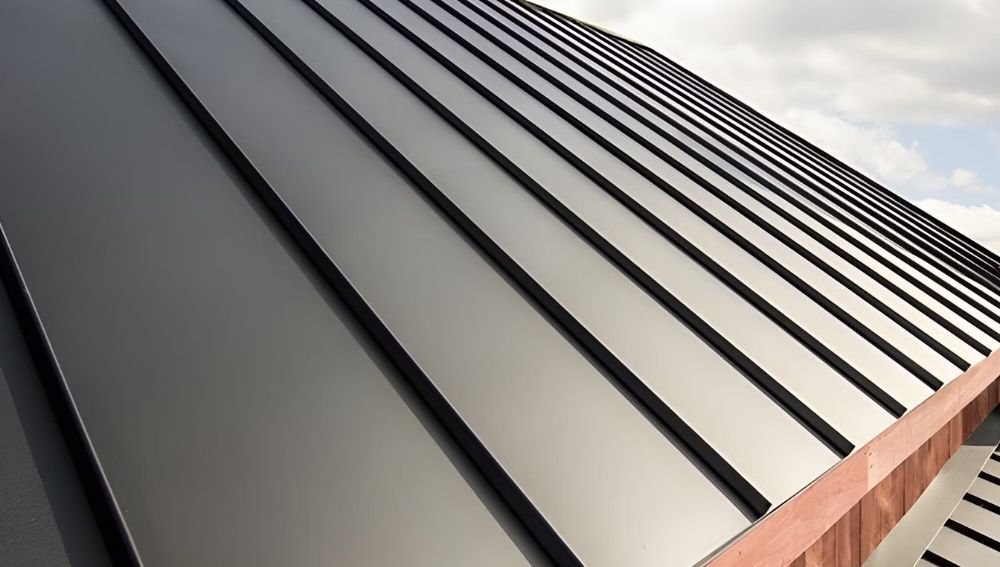
Standing seam roofing is a type of roofing system with vertical metal panels with interlocking seams. Use this roofing style for residential and commercial structures due to its durability, longevity, low maintenance, and sleek appearance. Here’s a more in-depth explanation of the standing seam metal roofing system:
- Materials: Make standing seam metal roofs from various materials, including aluminum, copper, zinc, or steel. Steel is the most commonly used material for standing seam roofing as it provides strength, durability, and affordability.
- Profile: The standing seam profile features vertical panels raised or standing above the roof’s surface. The panels have interlocking seams that run vertically down the top, hence the name “standing seam.”
- Installation: Standing seam roofing is installed in long runs using specialized equipment. The panels are crimped together at the seams using a machine and fastened to the underlying structure. This type of installation technique ensures a watertight and secure roof system.
- Weather Tightness: Design standing seam metal roofing as a weather-tight system that can withstand harsh weather conditions. The interlocking seams create a barrier preventing water and wind from entering the structure.
- Durability: Metal roofing is known for its durability and longevity. The standing seam roofing system is no exception, with a lifespan of 30 to 50 years if regularly maintained. The metal panels are resistant to corrosion, impact, and fire.
- Sustainability: Metal roofing is an eco-friendly option as it is recyclable. Manufacturers make these from recycled materials. The energy efficiency of standing seam metal roofing can also reduce energy costs by reflecting solar radiant heat and reducing cooling demands.
- Design Options: While standing seam metal roofing is often associated with a sleek and modern appearance, it is also available in various colors, finishes, and panel widths to match different building styles and design preferences. Use custom curved panels for rounded or angled structures.
- With all these benefits, it’s no surprise that standing seam metal roofing is a popular choice for many residential and commercial properties. From its weather-tight installation to its durability and aesthetic appeal, it is no wonder why it’s one of the top roofing systems on the market.
Metal Shingle Roofing
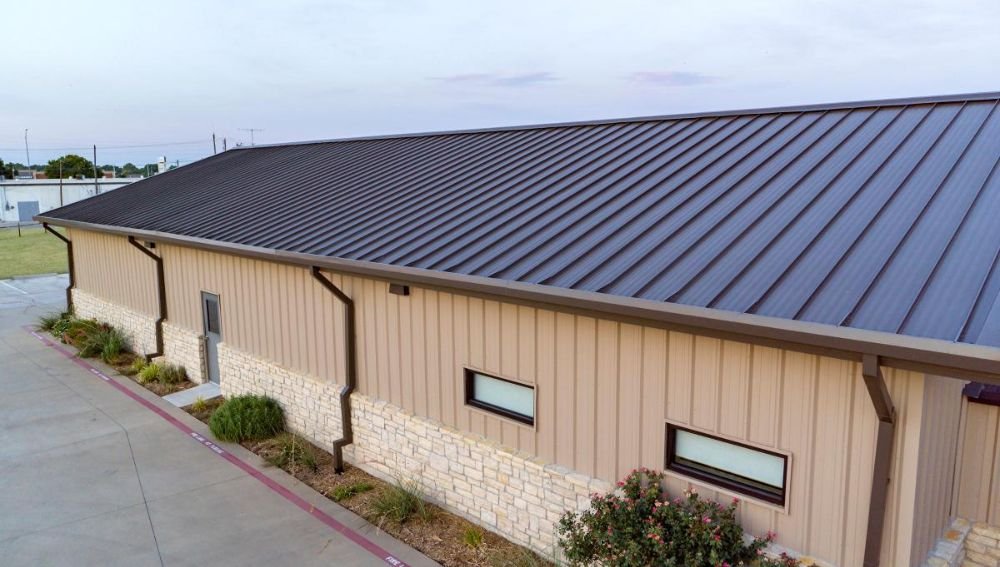
Metal shingle roofing is a type of roofing system that replicates the look of traditional shingles while offering the durability and performance benefits of metal. It combines the aesthetic appeal of asphalt shingles with the strength and longevity of metal roofing. Here’s a more in-depth explanation of metal shingle roofing:
- Appearance: Design metal shingle roofing to mimic the appearance of traditional roofing materials such as slate, wood shakes, or asphalt shingles. It offers various colors, textures, and styles to suit architectural and personal preferences.
- Materials: Make metal shingles from steel, aluminum, or copper. Steel is the most commonly used material due to its strength and affordability, while aluminum is known for its rust resistance and lightweight properties. Choose copper metal shingles for their distinctive appearance and natural weathering process.
- Interlocking Design: Metal shingles feature an interlocking design that allows them to connect securely to each other, creating a weather-tight barrier. This interlocking system prevents water infiltration and enhances the roof’s resistance to wind uplift, making it suitable for areas prone to strong winds or severe weather.
- Durability: Metal shingle roofing offers exceptional durability and longevity. Metal is resistant to rot, decay, and insect damage, which are common issues with traditional roofing materials. Metal shingles can withstand extreme temperatures, UV exposure, and hail impacts, ensuring the roof remains intact and protects the structure underneath.
- Low Maintenance: Metal shingle roofing requires minimal maintenance compared to other roofing materials. It doesn’t require regular cleaning or sealing and is less prone to moss, algae, and mold growth. Occasional inspections and debris clearing are typically sufficient to maintain the roof’s performance.
- Energy Efficiency: Metal shingles can contribute to the energy efficiency of a building. Coat many metal shingle options with reflective finishes, which reflect solar heat and reduce cooling costs. Additionally, the insulating properties of metal roofing can help regulate indoor temperatures and reduce heating costs in colder climates.
- Environmental Benefits: Metal shingle roofing is considered an environmentally friendly choice. Make most metal shingles from recycled materials. They can recycle them entirely at the end of their lifespan. Metal roofs also have a longer lifespan compared to other roofing materials, reducing the need for frequent replacements and reducing waste.
- Installation: Metal shingle roofing is typically installed with a concealed fastening system, preserving the roof’s clean and uniform appearance. The lightweight nature of metal shingles allows for easier installation and reduces the load on the roof structure.
- Longevity: Metal shingle roofing has an impressive lifespan, with many manufacturers offering 30 to 50 years or more warranties. This longevity eliminates the need for frequent roof replacements, saving homeowners time and money in the long run.
- Metal shingle roofing combines aesthetic appeal, durability, environmental benefits, and longevity, making it an attractive choice for homeowners seeking a durable and visually appealing roofing option. With its ability to withstand various weather conditions and low maintenance requirements, metal shingle roofing offers a valuable long-term investment for residential and commercial structures.
Corrugated Metal Roofing
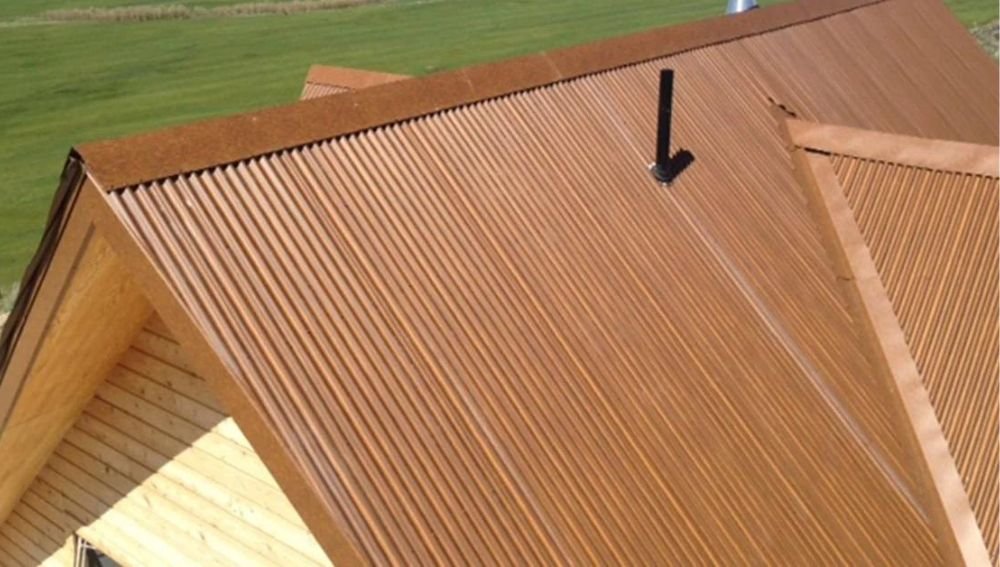
Corrugated metal roofing is a type of roofing material characterized by its distinctive wavy or corrugated pattern. It is a popular choice for residential and commercial buildings due to its durability, cost-effectiveness, and versatility. Here’s a more in-depth explanation of corrugated metal roofing:
- Structure: Manufacturers make corrugated metal roofing of flat metal panels formed into a wavy pattern. These waves, known as corrugations, provide structural strength and increase the rigidity of the metal sheets. The corrugated surface also allows for the metal’s flexibility and expansion/contraction in response to temperature changes.
- Materials: Corrugated metal roofing is commonly made from steel, although other materials, such as aluminum or zinc, can also be used. Roofers prefer steel due to its strength, affordability, and resistance to corrosion. Coat galvanized steel with a layer of zinc is a popular choice as it provides additional protection against rust and extends the roof’s lifespan.
- Installation: Corrugated metal roofing is relatively straightforward to install. To create a watertight seal, fasten the metal sheets to the roof deck or purlins using screws or nails with overlapping edges. Perform the installation process quickly and efficiently, reducing labor costs.
- Durability: Corrugated metal roofing is highly durable and can withstand various weather conditions. The metal panels are resistant to fire, rot, and insect damage. They can also handle heavy snow loads and are resistant to wind uplift. A corrugated metal roof can last several decades with proper installation and maintenance.
- Weather Protection: The corrugated design of the metal panels effectively channels water away from the roof, reducing the risk of water pooling or leakage. The overlapping edges of the panels create a seam that prevents rainwater from seeping through. This weather protection capability makes corrugated metal roofing particularly well-suited for heavy rainfall or snowfall areas.
- Versatility: Corrugated metal roofing is available in various styles, colors, and finishes. It allows for customization to match different architectural designs and personal preferences. The wavy pattern of the metal can create visual interest and add a unique aesthetic to a building.
- Energy Efficiency: Corrugated metal roofing can help improve the energy efficiency of a structure. It has reflective properties that reflect solar heat, thus reducing cooling costs in hot climates. Additionally, some manufacturers offer insulated corrugated metal panels that provide better thermal insulation, helping to reduce heating costs in colder regions.
- Cost-effectiveness: Corrugated metal roofing is more cost-effective than other roofing materials. Its relatively low installation and maintenance costs and long lifespan make it an attractive choice for budget-conscious homeowners and businesses.
- Environmental Considerations: Corrugated metal roofing is environmentally friendly in several ways. It is often made from recycled materials and is fully recyclable at the end of its life. The durability and longevity of corrugated metal roofing also reduce the need for frequent replacements, reducing waste.
- Corrugated metal roofing offers a range of benefits, including durability, versatility, cost-effectiveness, and weather protection. With its distinctive appearance, ease of installation, and long lifespan, it is no wonder that many homeowners and businesses choose corrugated metal roofing as their preferred roofing option.
Steel Roofing
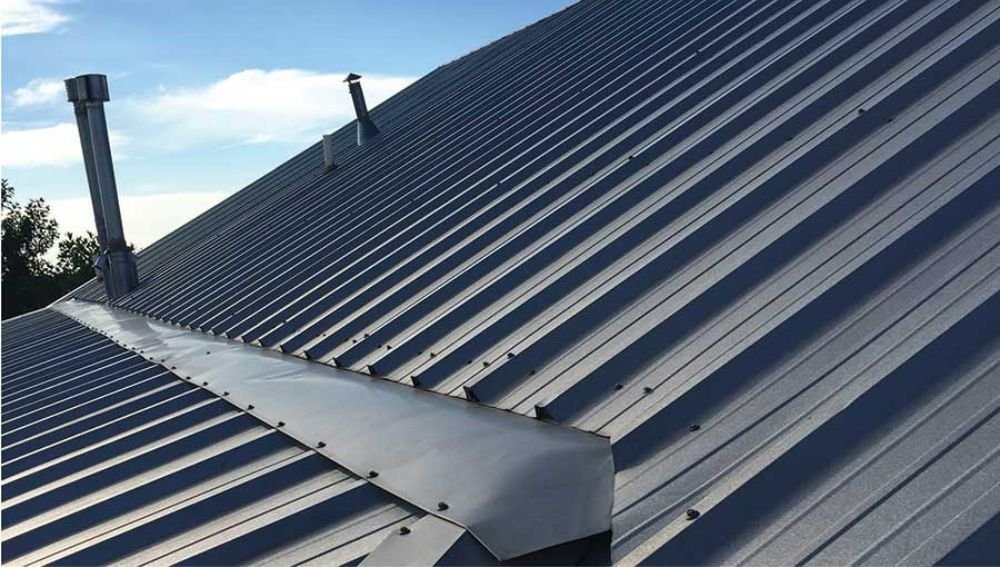
Steel roofing is a material commonly used in residential and commercial buildings for its durability, strength, and longevity. Made from steel, one of the most robust and durable materials available for roofing, it is resistant to extreme weather conditions, fire, pests, and aging. Here’s a more in-depth explanation of steel roofing:
- Materials: Make steel roofing from high-tensile, galvanized steel coated with a zinc layer. This coating protects against corrosion and rust, extending the roof’s lifespan. Coat some steel roofs with other materials like paint or ceramic, enhancing their durability and weathering resistance.
- Durability: Steel roofing is highly durable and can withstand extreme weather conditions, such as strong winds, hail, rain, and snow. Unlike other roofing materials such as asphalt, wood, and tile, it is also resistant to fire, pests, and aging. Due to their longevity and durability, steel roofs typically have extended warranties, ranging from 30 to 50 years.
- Design options: Steel roofing is available in various designs and styles, including standing seam, corrugated, and metal tile roofing. It gives homeowners and businesses great flexibility in terms of aesthetics and functionality. Roofers can color steel roofs in various colors, and their sleek and modern appearance can add value and curb appeal to any property.
- Energy efficiency: Steel roofing can help improve the energy efficiency of a building. Many steel roofs come with reflective coatings that reflect sunlight and UV radiation, reducing the amount of heat absorbed by the structure and lowering cooling costs. Ensure to design steel roofs to fit with solar panels or other green energy systems.
- Low maintenance: Steel roofing requires very little maintenance compared to other roofing materials. It is resistant to cracks, leaks, and losses in structural integrity. It also doesn’t require painting, cleaning, or sealing, as steel is resistant to moss, mildew, and other environmental contaminants.
- Cost-effective: Steel roofing is more expensive than asphalt shingles or other traditional roofing materials, but it has a longer lifespan, making it more cost-effective. It also has lower maintenance costs, which helps to reduce overall lifecycle costs.
- Installation: Steel roofing installation is relatively simple, particularly for standing seam or metal tile roofing. It is lightweight, so install it efficiently without requiring additional structural support. Steel roofing panels can also be installed over existing roofing materials, reducing installation costs and minimizing waste.
- Sustainability: Steel roofing is a sustainable and eco-friendly roofing option. Recycle steel material after its use as roofing material is complete. Install steel roofs with insulation can help reduce heating and cooling needs.
- Steel roofing is a popular and reliable option for homeowners and businesses, with a range of benefits in terms of durability, versatility, energy efficiency, low maintenance, cost-effectiveness, and sustainability. Its strengths and reliability have made it a popular choice worldwide, and it will continue to be a durable and reliable roofing option for decades.
Aluminum Roofing
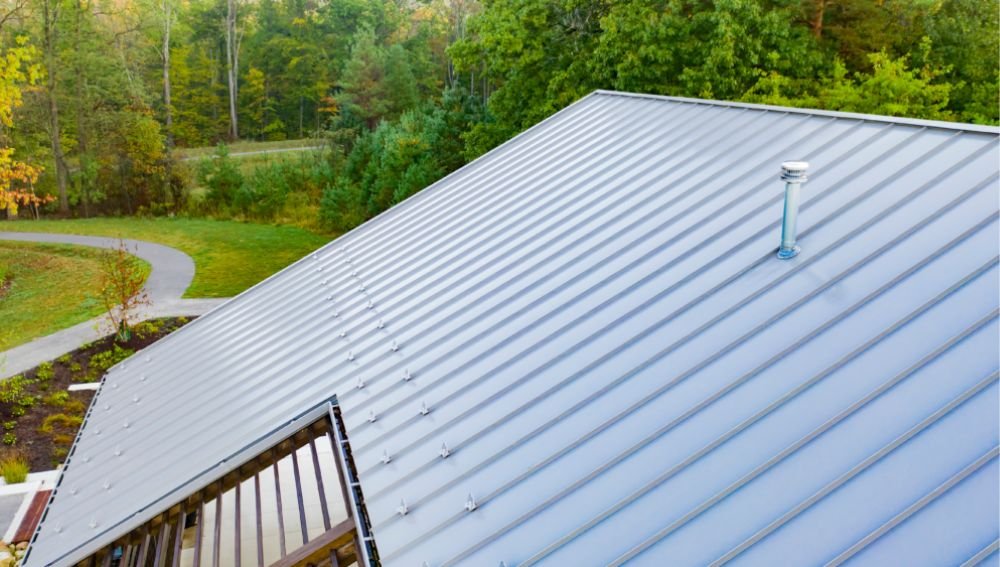
Use aluminum roofing in residential and commercial buildings due to its lightweight, durability, and corrosion resistance. It offers many benefits, making it an attractive choice for many homeowners and businesses. Here is a more in-depth explanation of aluminum roofing:
- Lightweight: One of the critical advantages of aluminum roofing is its lightweight nature. Aluminum is significantly lighter than other roofing materials, such as steel or tile. This lightweight quality makes the installation process easier and faster, reduces the load on the building structure, and can potentially reduce construction costs.
- Durability: Aluminum roofing is highly durable and long-lasting. Aluminum is naturally corrosion-resistant, which means it is impervious to rust and rot, making it ideal for areas with high humidity or coastal regions. It also withstands extreme weather conditions, including heavy rain, strong winds, and hail storms. Aluminum roofing is also resistant to fire, pests, and UV rays, making it a reliable option for long-term protection.
- Flexibility: Aluminum is a malleable material easily shaped, bent, and formed into various roofing designs and profiles. This flexibility allows for customization to fit the specific architectural requirements and design preferences of a building. It can imitate premium roofing materials like slate, shingles, or tiles, providing a similar aesthetic without the added weight and expense.
- Corrosion Resistance: Aluminum has a natural protective oxide layer that forms on its surface when exposed to oxygen, protecting it from corrosion. It makes aluminum roofing highly resistant to rust and deterioration, even in harsh environments. The corrosion resistance ensures that the roof will maintain its appearance and functionality over time, reducing maintenance needs and extending its lifespan.
- Energy Efficiency: Aluminum roofing has excellent energy-saving properties. It is highly reflective, which helps to reflect solar heat away from the building, reducing cooling needs and saving energy costs. Additionally, aluminum roofs can be installed with insulation materials to improve energy efficiency by reducing heat transfer and minimizing energy loss.
- Low Maintenance: Aluminum roofing requires minimal maintenance compared to other roofing materials. Due to its corrosion-resistant properties, do not require regular painting or coating to maintain its appearance and integrity. Aluminum roofs are easy to clean and can be rinsed with water or mild detergent to remove debris or dirt buildup. Recommend periodic inspections for damaged or loose panels to ensure the roof’s longevity.
- Eco-Friendly: Aluminum roofing is considered an environmentally friendly roofing option. Aluminum is a highly recyclable material. Make most aluminum roofing products from recycled aluminum recycled at the end of their lifespan. Its lightweight nature also reduces transportation and energy consumption during manufacturing and installation processes.
- Cost-Effective: Although aluminum roofing can cost more upfront than other roofing materials, it offers long-term cost-effectiveness. Its durability and low maintenance requirements eliminate the need for frequent repairs or replacements, reducing maintenance costs over time. Additionally, energy-saving properties can result in lower cooling costs, contributing to overall cost savings.
- Aluminum roofing is a reliable and sustainable option that offers a range of benefits, including lightweight design, durability, corrosion resistance, flexibility, energy efficiency, low maintenance, and long lifespan. Its qualities make it an excellent choice for various architectural styles and climates, providing lasting protection and aesthetic appeal to any building.
Stone-Coated Metal Roofing
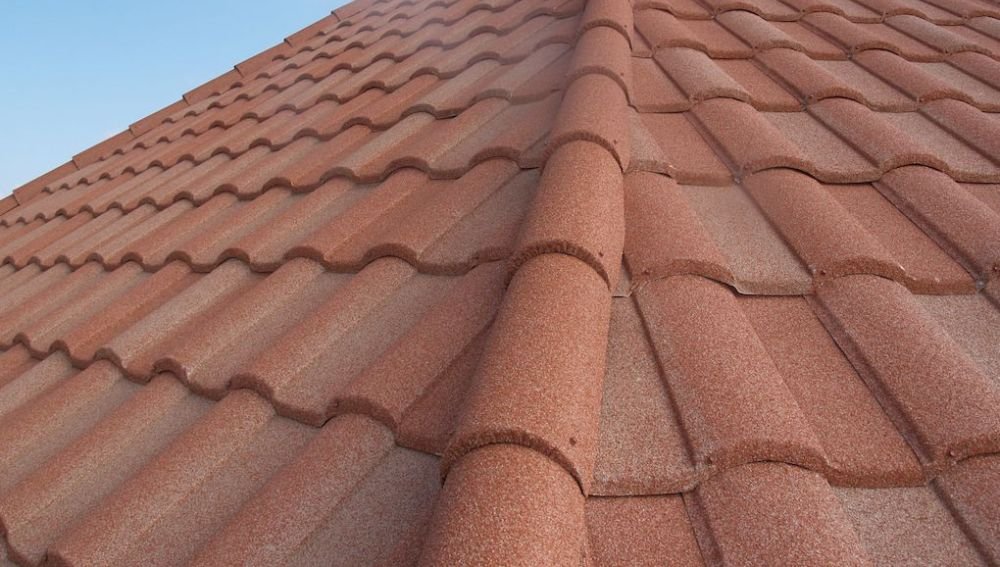
Stone-coated metal roofing is a unique type of roofing material that combines the durability and strength of metal with the aesthetic appearance of traditional roofing materials like asphalt shingles or clay tiles. It consists of metal panels with a layer of stone chips or granules adhered to the surface. Here is a more in-depth explanation of stone-coated metal roofing:
- Materials: Typically make stone-coated roofing panels from a base metal such as galvanized steel or aluminum. Form the metal into boards or tiles that mimic the appearance of traditional roofing materials. A layer of acrylic or epoxy resin is then applied to the surface of the metal, followed by a layer of natural stone chips or granules. The stone chips provide both aesthetics and additional protection to the underlying metal.
- Durability: Stone-coated metal roofing is highly durable and long-lasting. The metal base provides excellent strength, resistance to impact, and protection against extreme weather conditions, such as strong winds, hail, and heavy snow. The applied stone chips or granules enhance the roof’s durability by providing additional impact resistance and UV protection.
- Aesthetics: Stone-coated metal roofing offers a wide range of design options and can mimic the appearance of various traditional roofing materials. Made to resemble clay tiles, slate, wood shakes, or asphalt shingles. It gives homeowners the flexibility to achieve the desired aesthetic appeal of their roof while enjoying the benefits of a more durable and long-lasting material.
- Weather Resistance: Stone-coated metal roofing provides superior resistance to weathering. The metal base is naturally resistant to corrosion, rust, and degradation. The stone chips or granules protect the metal from UV radiation, preventing fading, cracking, or deterioration. This combination of metal and stone ensures that the roof can withstand harsh weather conditions and retain its aesthetic appeal for many years.
- Energy Efficiency: Stone-coated metal roofing can improve energy efficiency and reduce energy costs. The metal base reflects solar heat, reducing the heat the building absorbs. It helps to keep the interior cool and lowers the demand for air conditioning. Stone-coated metal roofing can be installed with insulation materials to improve energy efficiency further.
- Low Maintenance: Stone-coated metal roofing requires minimal maintenance compared to traditional roofing materials. The stone chips or granules protect moss, mildew, and algae growth. The metal base is resistant to rot, cracks, and leaks. Regular inspection and cleaning to remove debris or dirt buildup are all required to maintain the roof’s integrity and appearance.
- Fire Resistance: Stone-coated metal roofing is highly fire-resistant. The metal base is non-combustible, and the stone coating helps to prevent the spread of flames in case of fire. It provides an added layer of safety and peace of mind for homeowners.
- Longevity: Stone-coated metal roofing has a long lifespan, with many manufacturers offering 30 to 50 years or more warranties. The combination of metal durability and protective stone coating ensures that the roof can withstand the test of time and provide reliable protection for an extended period.
- Stone-coated metal roofing offers the best of both worlds: the durability and strength of metal roofing combined with the aesthetic appeal of traditional roofing materials. Its durability, resistance to weathering, aesthetic options, energy efficiency, low maintenance, fire resistance, and long lifespan make it an excellent choice for homeowners who seek a reliable and attractive roofing solution.
Copper Roofing
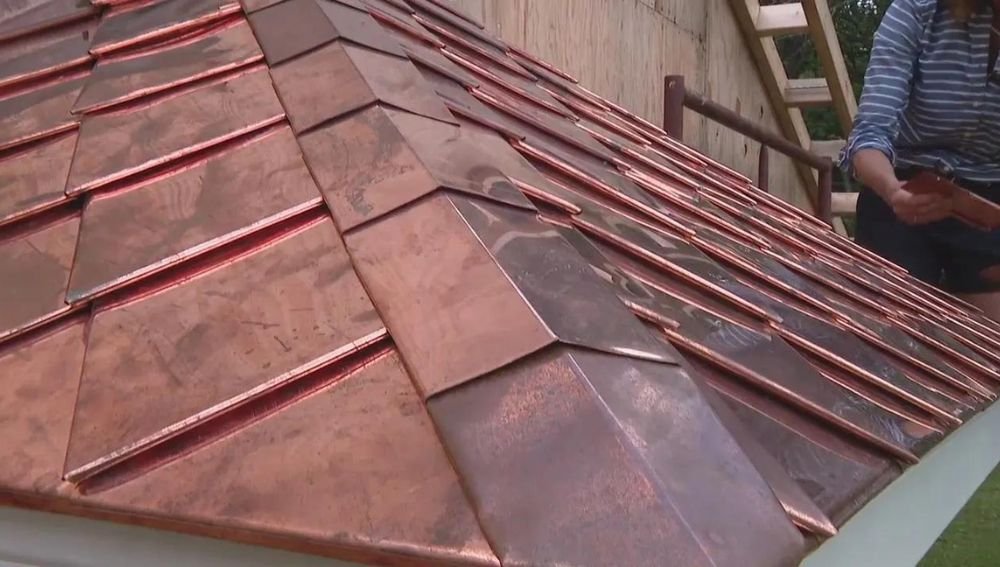
Make copper roofing a durable and corrosion-resistant metal. Copper has been used as a roofing material for centuries and is known for its unique and distinctive appearance. Here is a more in-depth explanation of copper roofing:
- Durability: Copper roofing is highly durable and can last for centuries. Copper is a naturally durable metal that withstands extreme weather conditions, including strong winds, heavy rain, hail, and snow. It is resistant to corrosion, rust, and degradation, making it an excellent choice for areas with high humidity or coastal regions. Copper roofing does not require frequent repairs or replacements, resulting in long-term cost savings.
- Aesthetic Appeal: Copper roofing offers a distinct and attractive appearance that many homeowners find appealing. When first installed, copper has a bright and shiny finish that gradually weathers to develop a unique patina over time. This natural patina gives copper roofs a beautiful greenish-blue or brownish color, adding character and sophistication to a building’s architecture. The evolving patina also helps copper roofing blend seamlessly into the surrounding environment.
- Longevity: Copper roofing has an extremely long lifespan than other roofing materials. Copper roofs can easily last 100 years or more with proper installation and maintenance. It is a highly sustainable roofing option that does not contribute to landfill waste like many other roofing materials.
- Lightweight: Despite its durability and longevity, copper roofing is relatively light in weight compared to clay tiles or concrete materials. This lightweight nature reduces the load on the building structure and can lower construction costs. It also allows more accessible and faster installation, reducing labor time and expenses.
- Flexibility: Copper is a malleable metal, making it highly flexible and versatile for roofing applications. It can be easily shaped, bent, and formed into various roof designs and profiles, including domes, barrels, or architectural accents. This flexibility allows for creativity and customization, enabling copper roofing to be tailored to specific architectural styles and design preferences.
- Environmental Benefits: Copper is a sustainable and environmentally friendly roofing material. It is 100% recyclable and can be reused indefinitely without losing its performance characteristics. Choosing copper roofing can reduce the demand for new raw materials and minimize the environmental impact of manufacturing and disposal. Additionally, copper has natural anti-microbial properties that discourage the growth of algae, moss, and fungi on the roof, reducing the need for chemical treatments or cleanings.
- Thermal Efficiency: Copper has excellent thermal properties, contributing to building energy efficiency. It reflects significant solar heat, reducing cooling costs during hot summer months. Copper roofing can also be installed with insulation materials to enhance energy efficiency further and minimize heat loss, especially during colder seasons.
- Low Maintenance: Copper roofing requires minimal maintenance to maintain its performance and appearance. Over time, the natural patina that develops on copper roofs acts as a protective layer, preventing corrosion and reducing the need for painting or coating. Regular inspections to ensure the roof’s integrity and clearance of debris or leaves are typically all required to keep copper roofing in optimal condition.
- Copper roofing offers a range of benefits, including durability, aesthetic appeal, longevity, lightweight design, flexibility, environmental sustainability, thermal efficiency, and low maintenance. Its timeless beauty, exceptional durability, and sustainability make it a premium choice for homeowners seeking a long-lasting, visually striking roofing solution.
Discuss The Environmental Benefits of Metal Roofing
Metal roofing offers several environmental benefits, making it a sustainable and eco-friendly option. Here are some of the key environmental advantages of metal roofing:
- Long Lifespan: Metal roofing has an exceptionally long lifespan compared to other roofing materials. It can last 50 years or more with proper installation and maintenance. This longevity reduces the need for frequent roof replacements, which contribute to landfill waste and the extraction of new raw materials. Homeowners can help reduce their environmental impact by minimizing the waste generated from roof replacements by choosing metal roofing.
- Recyclability: Metal roofing is highly recyclable and can be reused indefinitely without losing its performance characteristics. At the end of its life cycle, metal roofing materials can be recycled and transformed into new metal products. Recycling metal requires significantly less energy than manufacturing new metal from raw materials, reducing energy consumption and greenhouse gas emissions. Opting for metal roofing promotes a circular economy and reduces the demand for new raw materials.
- Energy Efficiency: Metal roofing has excellent energy-efficiency properties. It reflects a significant portion of solar heat, reducing the heat absorbed by the building and lowering cooling costs. It can help lower energy consumption associated with air conditioning in hot climates. Additionally, metal roofing can be installed with insulation materials, further enhancing energy efficiency by reducing heat loss during colder seasons.
- Cool Roofing: Design metal roofing can with cool roof technology. Cool roofs reflect more sunlight and absorb less heat than traditional roofing materials. By reflecting sunlight, cool metal roofs help reduce the urban heat island effect, improving local microclimates and reducing the need for energy-intensive cooling systems. Lowering energy consumption for cooling contributes to a reduction in greenhouse gas emissions.
- Reduced Waste: Install metal roofing in large, durable sheets or panels. It minimizes the number of roofing materials needed and reduces waste generated during installation. The ability to custom-cut metal roofing to specific dimensions during manufacturing also helps reduce waste on the job site. Additionally, metal roofing does not require regular maintenance or frequent repairs, reducing waste from roof maintenance activities.
- Water Collection: Metal roofing is conducive to water collection and rainwater harvesting. The smooth surface of metal roofs allows rainwater to flow quickly and efficiently into gutters and downspouts, making it easier to collect and store rainwater for various purposes, such as irrigation or household use. Promoting rainwater harvesting contributes to conservation efforts and reduces reliance on municipal water supplies.
- Fire Resistance: Metal roofing is highly fire-resistant compared to other roofing materials, such as wood or asphalt shingles. It does not contribute to the spread of fires, which can help protect homes and surrounding properties. Metal roofing can minimize the risk of fire-related damage and increase overall safety.
- By considering metal roofing for their homes, homeowners can contribute to environmental sustainability by reducing waste, promoting recycling, conserving energy, and minimizing the environmental impact of roof replacements. The long lifespan and recyclability of metal roofing make it an excellent choice for eco-conscious individuals who seek a durable and environmentally friendly roofing solution.
- In conclusion, the comparison of metal roofing and asphalt shingles highlights several key points to consider:
- Durability and Lifespan: Metal roofing has a longer lifespan of 50 years or more, while asphalt shingles typically last around 20-30 years.
- Weather resistance: Metal roofing is highly resistant to extreme weather conditions like high winds, rain, and hail, whereas asphalt shingles can be more vulnerable to damage.
- Energy efficiency: Metal roofing is energy-efficient, reflecting solar heat and reducing cooling costs. In contrast, asphalt shingles absorb heat, potentially increasing energy consumption for cooling.
- Cost considerations: Metal roofing generally has a higher initial cost but may provide long-term cost savings due to its durability and low maintenance requirements. Asphalt shingles have a lower upfront cost but may require more frequent replacements and maintenance.
- Aesthetics: Both metal roofing and asphalt shingles offer a variety of styles and colors. Metal roofing complements modern or contemporary designs, while asphalt shingles are
- versatile and suitable for various architectural styles.
- Individual preferences and specific needs: The choice between metal roofing and asphalt shingles ultimately depends on personal preferences, the particular needs of the building, and budget constraints.
- Consulting with a professional roofing contractor is highly recommended to assess factors such as climate, roof structure, design, and budget. They can provide expert advice and help weigh the pros and cons to determine the most suitable roofing material for your project.
Bottom Line
If you have the money to invest in your home, a metal roof’s cosmetic and practical improvements are worth the input. Asphalt shingles are more common, and finding roofing contractors prepared to fix any asphalt shingle roof immediately is pretty straightforward. Both roofing materials work and have worked for decades.
A low-quality metal roof will not provide the same performance as a high-quality shingle roof, so for those looking for the best bang for the buck, a decent-quality shingle roof will suit any hous
Your Home. Your Decisions. Our Support.
Get expert advice on your home, design tips, how much to pay for pros and hiring experts, delivered daily.
We welcome you to the Innercity Roofers Home Improvement Community!
{{ newsletterState.emailErrorMsg }}
I agree to receive the Innercity Roofers Home newsletter via e-mail. Please see our Privacy Policy for more information and details on how to opt-out.
